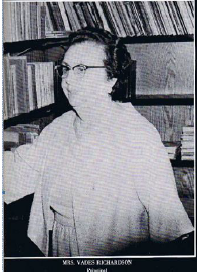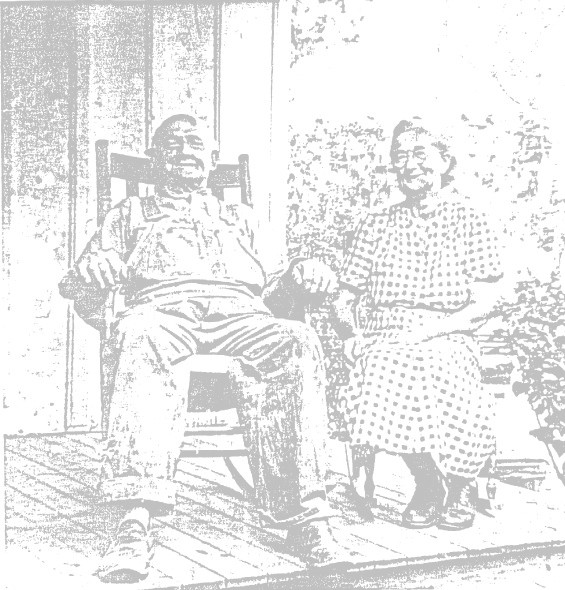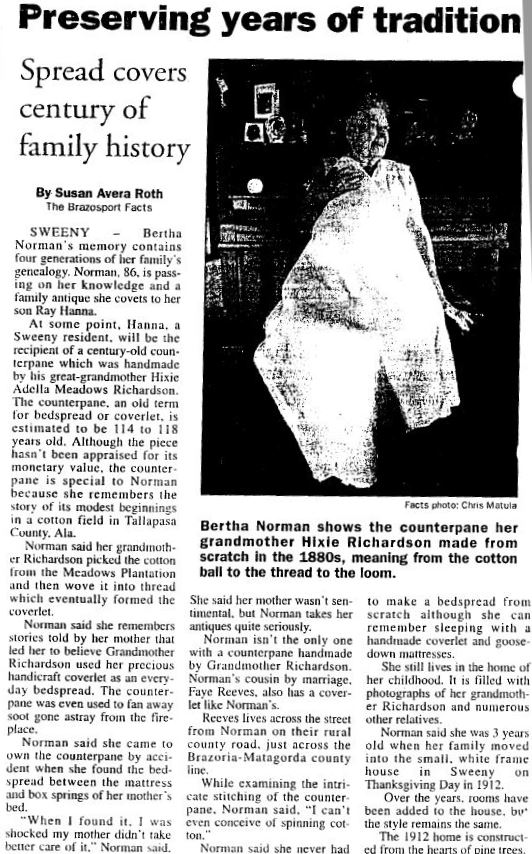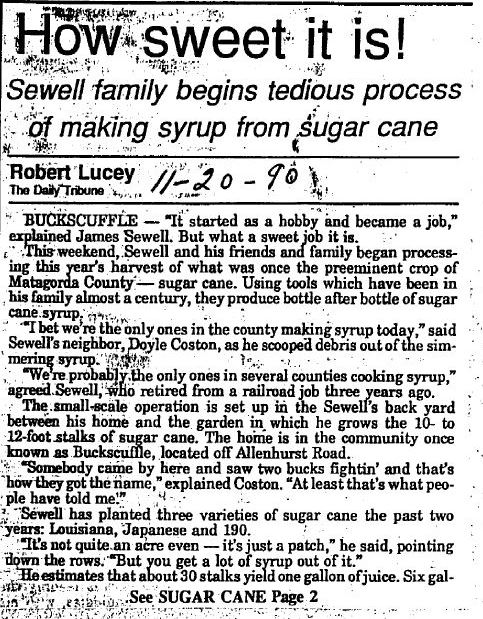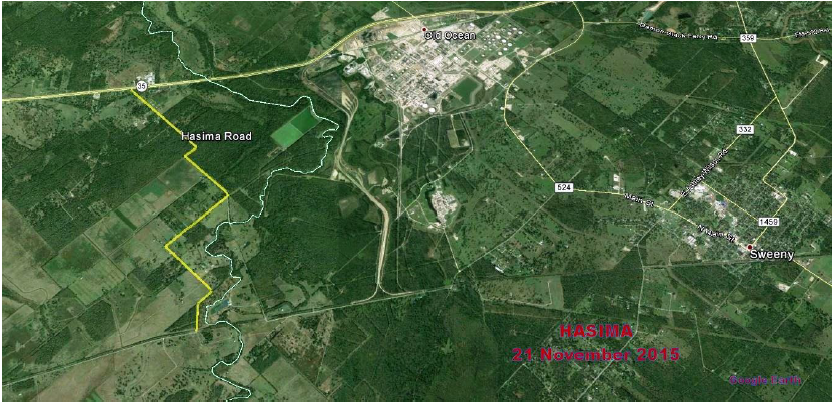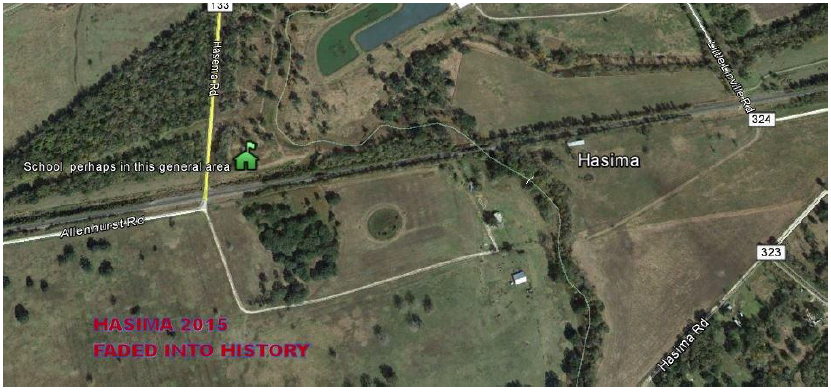Today, most people in the Sweeny area think of Hasima (or Hasema) as being an area along Hasema Road west of Old Ocean & Sweeny down to the railroad tracks & home of the perhaps fabled "Wild Woman of Hasima" in 1926. This land is in both Brazoria and Matagorda counties. Historically, the spelling is Hasima but highway signs and some maps say Hasema. Reason unknown. There was actually a platted township of Hasima which never developed like Sweeny. Though the town site development plans were never fulfilled, a rural community eventually grew up along the route known locally as Hasima road. Some land records show Hasima & Staggs roads together as Sweeny Bay City Road.
Like the chicken & the egg, we have yet to establish which came first….the name Hasima or the Hasima plat.
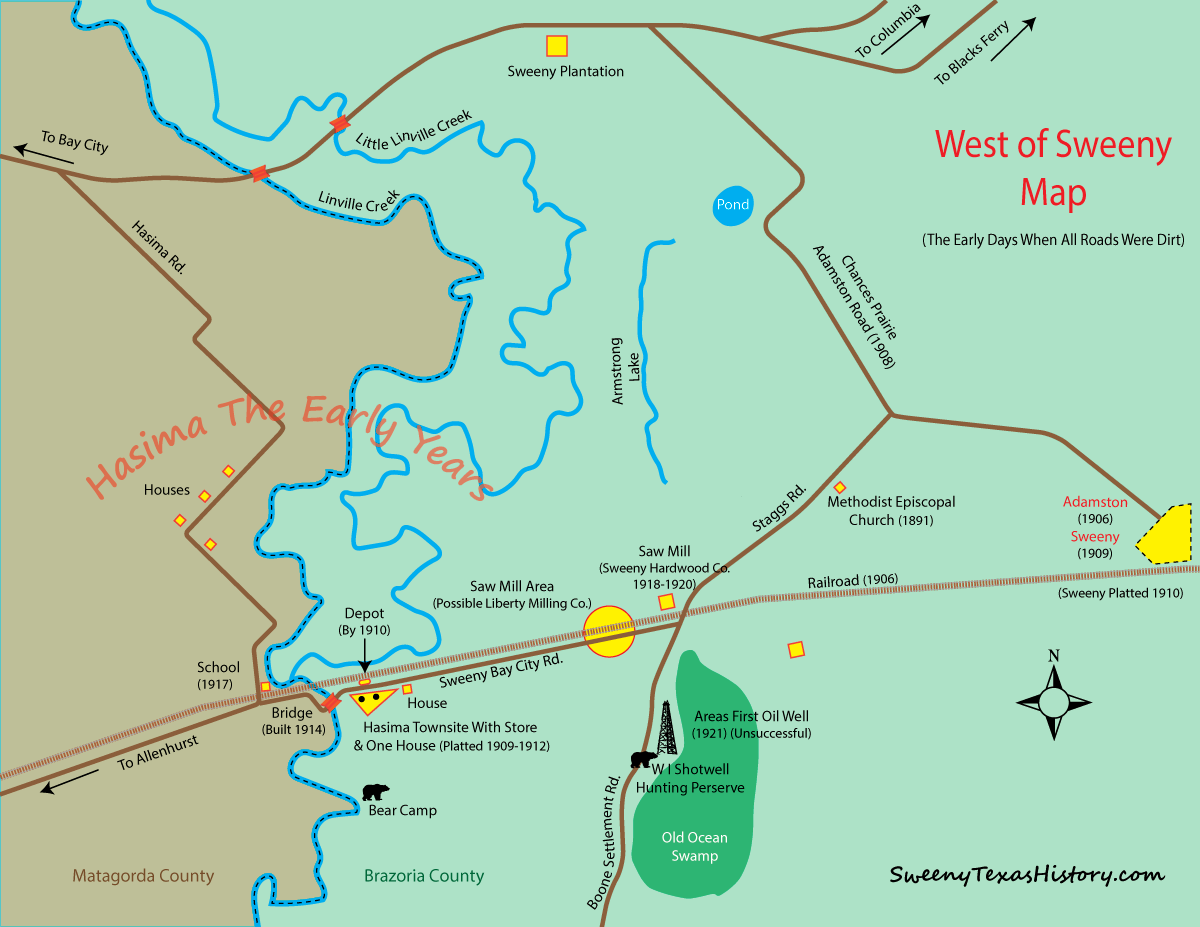
The section of Hasima Road that passed by the depot and store and then over the wooden bridge (built 1914) at Linville Creek into Matagorda County no longer exists. Faint traces of it show up on old aerial photographs & modern day satellite views. A possible low water crossing can be seen just downstream.
Hasima also had the nicknames "BUCKSCUFFLE DELTA" & "THE BOTTOMS". Origin unknown. Real estate ads also called the area "HASIMA COLONY".
HASIMA TOWNSHIP
In the early 1900's, the new St Louis, Brownsville & Mexico Railroad spawned growth in the area and new cities were laid out along its path. Sweeny (Adamston) got a depot about 1906-1907 & the city was platted in 1911. Although "Hasima" was shown on plats of at least two other neighboring land records as early as December 1908, no evidence was found that the Hasima Townsite Plat was ever recorded with Brazoria County. Allenhurst, a few miles west in Matagorda County was also platted but it is unknown to us if it was recorded in Matagorda County. Of the three, only Sweeny survived and the other two just faded away.
Hasima, said to have been named after the three sons of the contractor (name unknown) who cleared the land, never took off with only a few lots being sold and the township was cancelled in 1941. See Appendix B for some of the land history.
 |
 |
|
Sign @ Hwy 35 Google Earth |
Google Earth 1943 |
| THE THREE SONS
HArry SImon MArion
HASIMA |
 |
| Google Earth 2014 | |
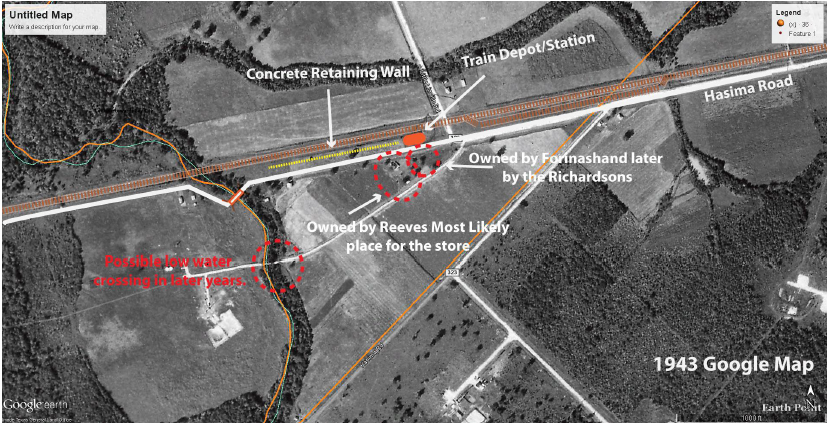 |
|
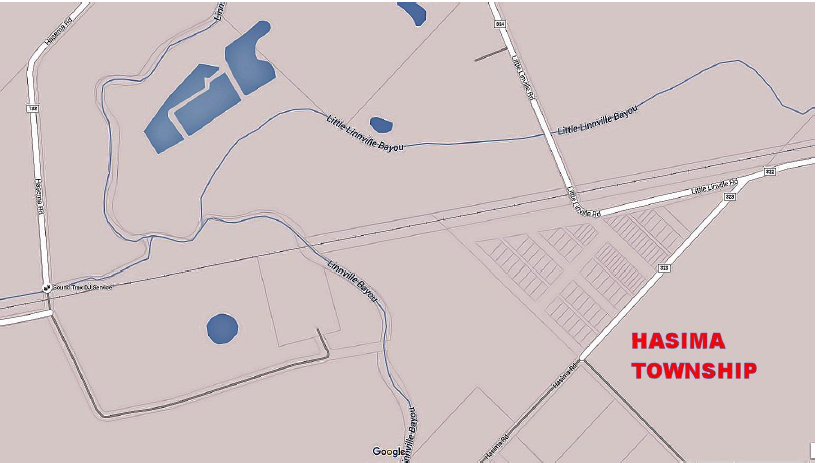
 |
 1918 Data From Precise Leveling in Texas 1918 Data From Precise Leveling in Texas |
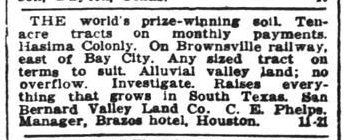 Houston Post Nov. 1909 via The Portal to Texas History
Houston Post Nov. 1909 via The Portal to Texas History Industrial Development and Manufacturers' Record, Volume 55LAND SALE PROMOTIONS
Industrial Development and Manufacturers' Record, Volume 55LAND SALE PROMOTIONS
Various companies besides McDonald & Company were promoting land sales in the area.
BRIDGE OVER LINVILLE CREEK
As the population grew, there became a real need for a bridge over Linville Creek. When the water level made it impossible to ford the creek, people were resorting to crossing on the railroad trestle. After negotiations with both Brazoria & Matagorda counties, a bridge was built in 1914. Later in the article, it is referred to as the rattling, rumbling old wooden bridge describing the noise when horses & wagons passed over it. The bridge no longer exists. See appendix A for copies of related historical documents.
RAILROAD
The railroad coming thru the area made things happen not unlike a new major street or highway today will cause new homes & businesses to spring up in its path. In 1905,the St. Louis, Brownsville & Mexico Railway started laying track east of Angleton, across the Brazos River at Brazoria, across the San Bernard River east of what would become Sweeny, and on toward Hasima, Allenhurst to Bay City. This was no easy feat thru the river bottoms and hardwood forests of Brazoria County .See details and pictures in the book Gringo Builders here.
The depot at Hasima apparently was built sometime in 1908-1910. It is not shown as a stop in January 1908 but is in September 1910.
1908 Data
Notice Sweeny listed as Adamston
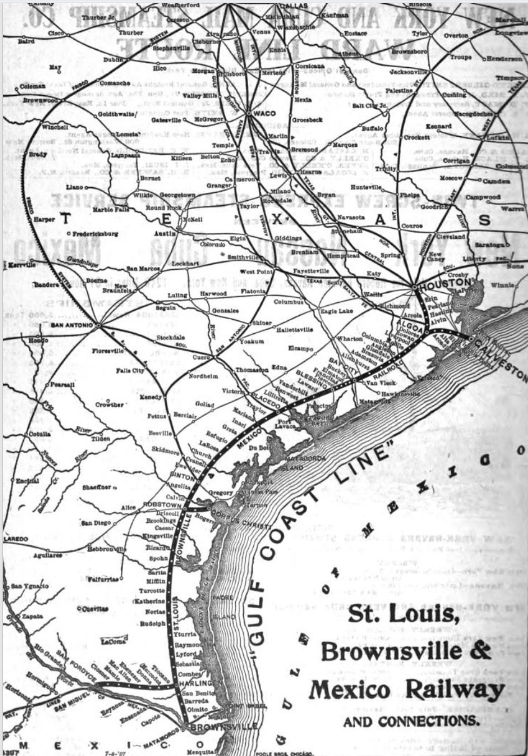
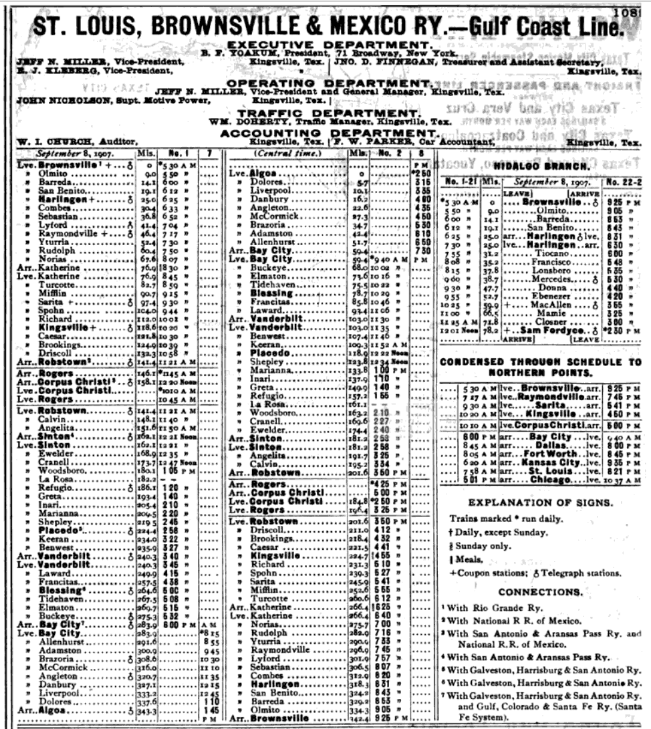
The September 1910 schedule does list Hasima as a stop so the depot must have been in place by that time. Adamston now reads SWEENY.
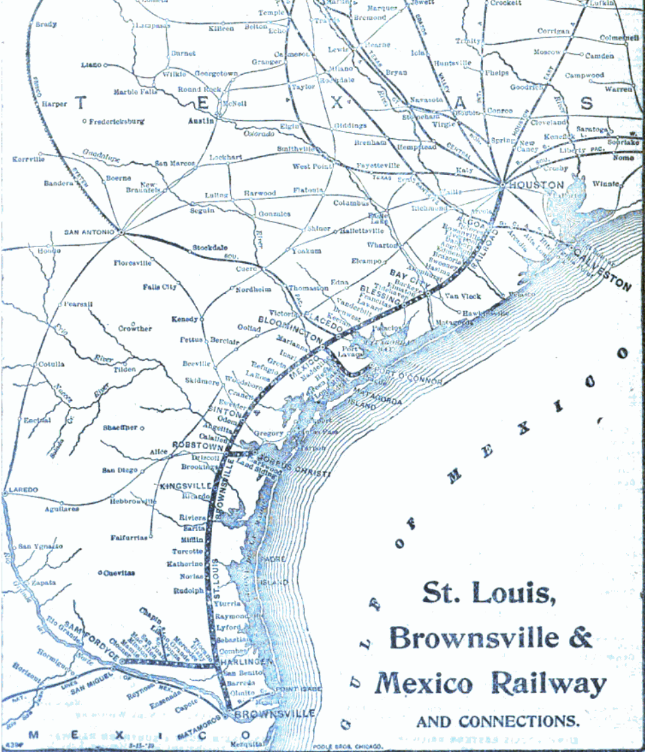
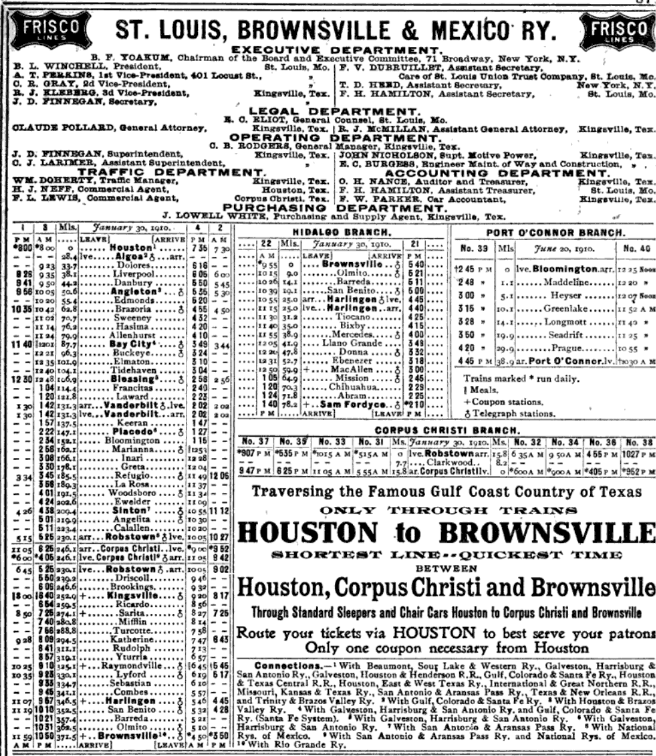
Route & timetable data comes from
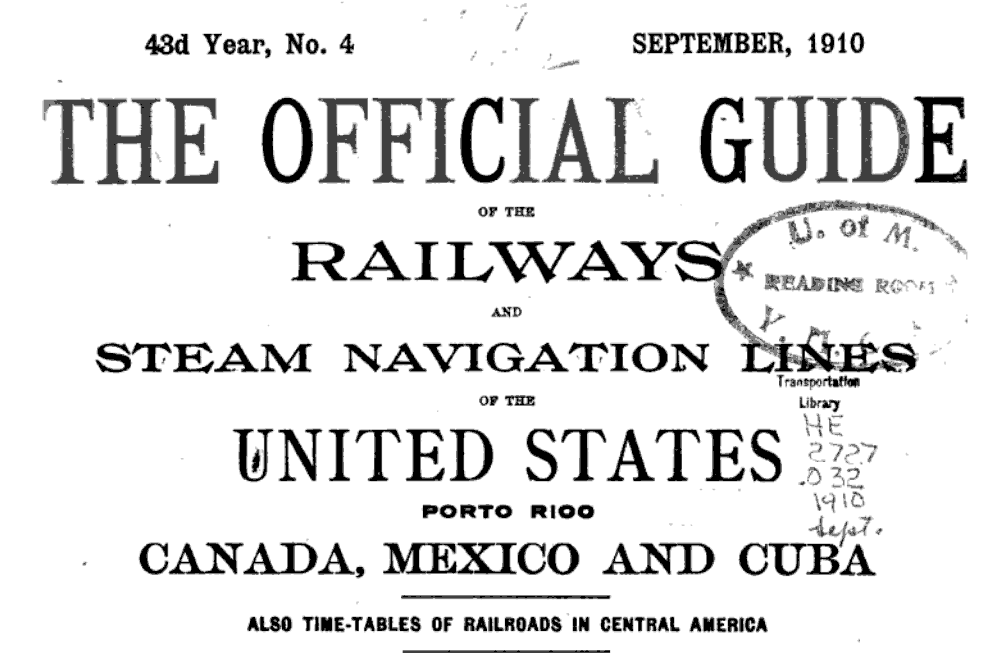
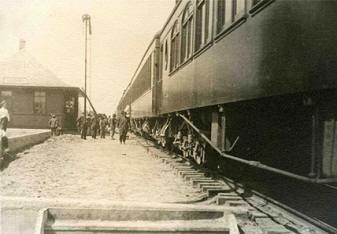 |
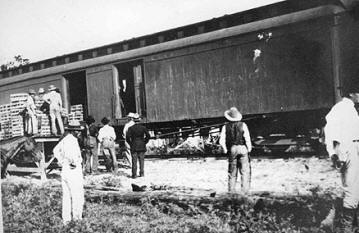 |
| Notice the concrete retaining wall in the left of the picture above is described below: | Loading Chickens |
C 52.—At Hasima, Brazoria County, on the top surface in the southeast corner of the concrete retaining wall around the station ground of the StLouis, Brownsville & Mexico Railway. A brass disk. (10.998 meters or 36.083 feet.)
D 52.—About 1.9 miles northeast of Hasima, Brazoria County, 20 meters (66 feet) southeast of milepost 298 of the St. Louis, Brownsville & Mexico Rail way, 50 meters (164 feet) south of the trestle, 5 telegraph poles northeast of a spur line to the sawmill owned by the Sweeney Hardwood Co., and 12 meters (39 feet) southeast of the track. A concrete post with disk in top. (9.771 meters or 32.057 feet.)………………U. S. COAST AND GEODETIC SURVEY
SCHOOL
A school building was erected about 1917/1918 on one acre of land donated by McDonald & Company west of Linville Creek in Matagorda County. Prior to that, the children of the area were taught in the upstairs of the local store and the home of one of the residents. There are slight date variations between accounts.
From Bertha Hanna Norman's (1909-2001) memoirs.(Charlene Finley files) "My first year of school (would have been about 1915-1916) was in the country store building upstairs; the store had a post office also. The next year school was held in Benjamin and Hixie Richardson's parlor in the year 1916 and into 1917. In the fall of 1917 a new school house was ready and centrally located for convenience of all the children; a teacher from Bay City, then another from Houston for 5 months, then in the fall of 1919, Miss Vades Underwood, later married to Joe Richardson became the teacher. In those days, after you finished the 7th grade, you were ready for high school. Miss Vades taught there until 1936*, and then Bertha's sister, Hixie Sewell, taught for 2 years. The school was then transferred to Van Vleck.
While at school one day during the noon hour, the kids found a coach whip (snake). They chased it into a hollow log, killed it, and took it back to the school house. Miss Vades measured it and it was nine feet long."
Matagorda County history site TxGenWeb site for Matagorda County contains much the same information with the addition that the school was built in 1918 on one acre of land donated by McDonald & Company.
From Peggy Sewell Baker(1925-2012) interview by bchm.org "Now oddly enough it wasn’t right there near what I considered the original site, but you cross Limble (Linville) Creek and cross that old rumbling bridge and go down a piece, you can go straight ahead and you go to Allen Hurse (Allenhurst), you can end up in Matagorda County. But right away if you cross over the railroad tracks again –you got it? Just a short piece there was the one room school house."
Where was the school located? Reading Peggy's memory above and looking at the image below, "cross Limble Creek…old rumbling bridge….down a piece ……Matagorda County…cross over the railroad tracks……………..short piece…one room school house." This seems to place the school on the west side of Linville Creek in Matagorda county near where Hasima Road intersects the railroad tracks. No trace of it exists today.
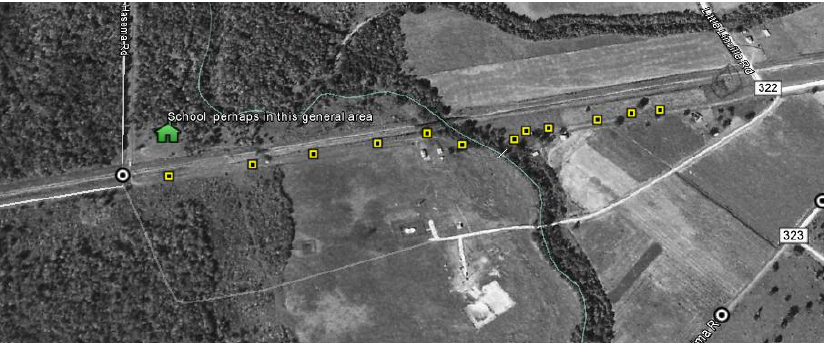
Mrs Vades Richardson taught at the Hasima School 1921-1936 except in 1923 when she took leave for childbirth & Miss Mary C. Bacon filled in. Mrs Richardson went on to become a principal at Sweeny. She died in 1966. (Picture From Sweeny Annual)
STORE(S)
The store in Hasima was called the Hasima Mercantile Company. It also served as the post office and school was held upstairs one year. Back in the day, stores such as this were the hub of the community not unlike the Smith store in Sweeny.
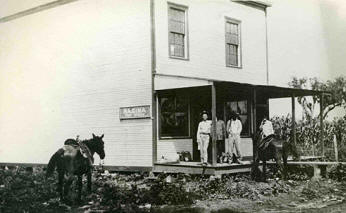 |
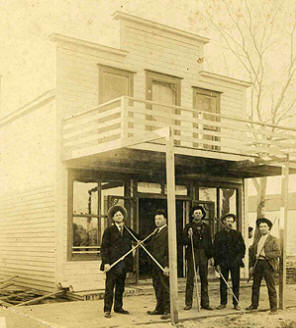 |
|
Identity of men unknown |
There may have been a 2nd store in the area possibly across LinvilleCreek somewhere in Matagorda County. More research required. |
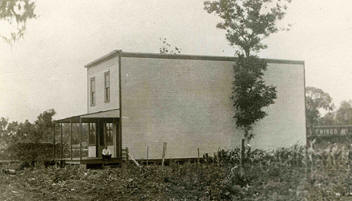 |
|
POST OFFICE
A post office was ordered established at Hasima on August 1, 1908, and Wesley Hunefelt appointed postmaster. However the order was rescinded September 2, 1908. Wesley was then appointed as postmaster of Adamston (Sweeny) 8 September, 1908.

Records of a post office in Hasima appear again in 1910 and continue off & on until 30 June 1921 when it was closed & mail service was transferred to Sweeny. No records have been found to date of any reopening after 1921.
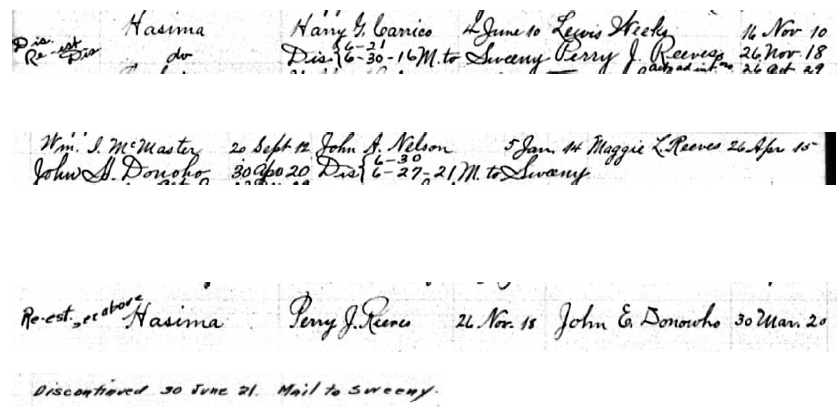
POSTMASTERS:
1908 (one month, apparently never opened) Wesley Hunefelt
4 June 1910 Harry G. Carrico
19 November 1910 Lewis Weeks
20 September 1912 W. I. McMaster
5 January 1914 John A. Nelson
26 April 1915 Maggie L. Reeves
30 June 1916 Discontinued. Moved to Sweeny
26November 1918 Perry J. Reeves
30 April 1920 John Donoho
30 June 1921 Discontinued. Moved to Sweeny
SWEENY HARDWOOD COMPANY
Land records indicate the Sweeny Hardwood company was started on 10 acres of land owned by E D Staggs in 1918. This 10 acres was later owned by Hallie Burt. This matches the precise leveling data. The mill included buildings, engines, boilers and saw mill equipment. Staggs bought from the McDonald Company. Staggs and others including J S Jones also purchased rights from McDonald Company for about 6,000 acres of merchantable live oak in both Breen and Oliver Jones leagues. Not sure when they made the purchase, but sold this and the 10 acres to J P Sallee in 1919. Sallee sells the 10 acres to the Burts in 1920, with stipulation that J. S. Jones owns the most eastern house (this would be in the area where John Burt now lives) and will move it and that he and a Dr. Weeks own all the sawmill equipment and will move that. The Burts in turn enter into an agreement with Jones where Jones will plat the 10 acres apparently to sell as lots. Records became confusing at this point, but we all know Hallie Burt later lived on these 10 acres. It also appears this mill was shuttered in 1920 so it could not be the one Peggy Sewell Baker mentions in the tape interview that follows in MEMORIES.
Lumber Trade Journal Volume 72, dated 1 Oct 1917, page 17. The article started; Houston, TX. H.G. Bohllson a hardwood manufacture of New Caney has just completed shipment of 300,000 feet of oak to this city, all of it being intended for use in the building of ship on the Houston Ship Channel. J.W. Blake manager of the Sweeny Hardwood Company announces his concern has just filled an order for 104,000 tree nails for Houston Ship builders.
LIBERTY HARDWOOD MILLING COMPANY
Research indicates there was a Liberty sawmill was operating in the area but the exact location is unknown. A long time resident of the Hasima area put the location of a mill in the general area circled on the map. This perhaps could have been Liberty.
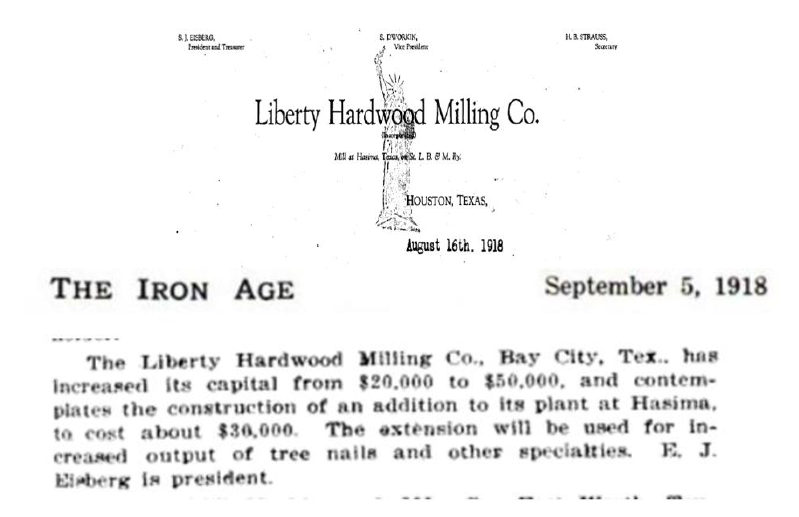 |
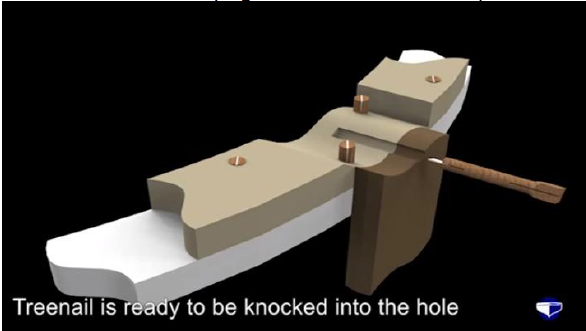 |
|
The Iron Age Volume 102 1918 |
Treenails were wooden pegs used in wooden ship construction |
For more information click here.
OTHER BUSINESSES IN AREA
Blacksmith shop, land companies.
AGRICULTURE
Once the land was cleared of the jungle of oak trees typical in the area, the soil beneath was probably like that in Sweeny, "SOIL RICHER THAN THE VALLEY OF THE RIVER NILE".
Sugar Cane
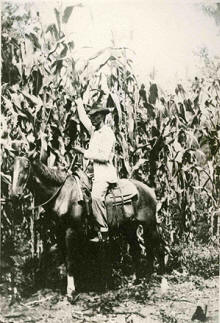 |
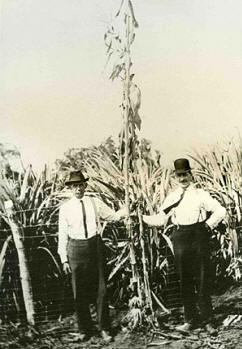 |
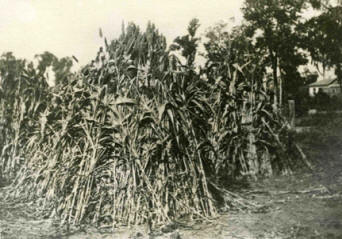 |
|
James Sewell making surgar cane syrup in later years.
|
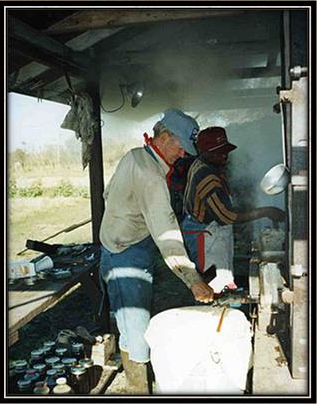 |
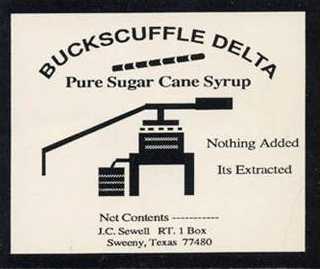 |
Other: corn, cotton, cattle, chickens
FAMILIES OF HASIMA
These families and others were the early settlers of the Hasima area and their family trees are intermingled much like Sweeny……..Most everybody in town is related in some way. See family trees in the genealogy section for further information.
|
Sewell Richardson Creel Reeves Starks Hanna |
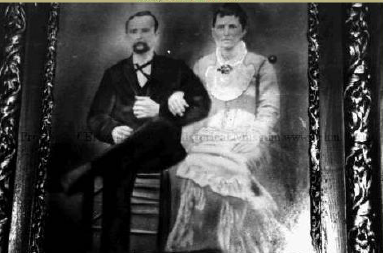 |
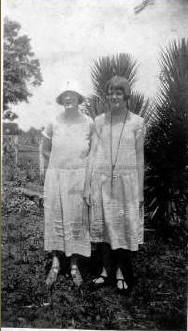 |
|
Images courtesy of the Brazoria County Historical Museum bchm.org |
||
| Benjamin and Hixie Meador Richardson |
LR Mary Edith Creel (1907-1995), Grace Creel |
|
Memories Part I
The following is part of a transcription of an 2003 taped interview with Peggy Sewell Baker (1925-2012) who was born in Hasima and was 78 years old at the time of this interview. Thanks to Brazoria County Historical Museum bchm.org for this material.
Added information & comments are shown in italics .
"For: Brazoria County Historical Museum, Angleton,Texas
Interviewed: Peggy Sewell Baker
Interviewer: David C. Pettus
Date: 11/7/2003
Transcribed by: Cleste Norris Hall April 15, 2011
START OF CASSETTE TAPE 1 OF 2, SIDE A
PETTUS: This is Pettus. I’m doing an oral history interview with Peggy Sewell Baker at the Brazoria Historical County Museum and this is November 7, 2003.
Okay, Mrs. Sewell. I mean Mrs. Baker, to start with could you tell us when and where you were born?
BAKER: I was born in Hasima June 14 _______ 1925. Flag Day and was taught very early to honor and respect Old Glory. And my days of patracism and we’ll know that World War I and those wars that have – we’re just so proud to see Old Glory when she waves. And in parts of the world, David, they can burn the flag. They can destroy books and can ____. The patracism, love, and respect is in our hearts.
PETTUS: Okay. Who were your parents?
BAKER: My dad was Elmer Lee—please put Shorty (1901-1983). Most people didn’t know Dad’s name. Sewell and that’s what’s on his tombstone.
PETTUS: That’s an unusual spelling of that name.
BAKER: Sewell.
PETTUS: Okay. And your mother?
BAKER: Mother, Mary Edith Creel (1907-1995 See picture above). Like a fishing creel, c-r-e-e-l. Dan was born out on the prairie out of Luling, Texas.
PETTUS: Okay.
BAKER: And Mother, in Edin, E-d-i-n. They said, Eden. Mississippi people talk funny. Edin, Mississippi.
PETTUS: Yes, my father was from Alabama and he told me that the Mississippi people talk funny too. He talked pretty funny also. Okay, you know what year they were born?
BAKER: I think Mother was born in 1912 and Dad, I know, ten years older there. So if you use your arithmetic.
PETTUS: 1907
BAKER: Uh-huh.
PETTUS: Okay.
BAKER: And Dad said they had a ____ there. So he wanted so badly to go into the Navy that he had ____ about it because he wanted so badly and rest his soul, I reckon it’s alright to tell it now, that he had a birthday in June.
PETTUS: A lot of people did that.
BAKER: I know.
PETTUS: It’s amazing to me.
BAKER: And I asked him why he did it. He said he was tired picking cotton.
PETTUS: That’s a good reason. Okay, and you told me that you did not have any brothers and sisters.
BAKER: No, I’m the only child.
PETTUS: Did you have any aunts and uncles?
BAKER: Oh yes. Oh, a slew of them. Some, they’re scattered. Now the grandsons on the mother’s side of the family, the Creel family, her daddy was a son of Creel was in the Civil War. Just a young boy. Isaiah Creel. And the mother was Elizabeth Edwards Creel (1849-1928). Both born I Mississippi. And Elizabeth Creel is buried in Swenny in the old parts of the Swenny Cemetery. I could walk you right to her grave marker."
PETTUS: Okay. Your father’s parents?
BAKER: William Cicero Sewell (1874-1939). And the mother, Bessie. B-s-s-i-e Cowan, but it’s not C-o-w-a-n, it’s K-e-o-w-n. (1876-1918)
PETTUS: That’s an Irish spelling.
BAKER: Yes, un-huh. And they too were not born in Texas, but you know. Did I tell you how most of my people, before automobiles, the poor people. I mean only reality people had automobiles. But they traveled by train, by wagons. I’m not talking stage coach. But my people, mother’s people came by immigration railroad.
PETTUS: Okay.
BAKER: Missouri-Mississippi. Incidentally, they were the Missouri-Pacific Railroad track was down there before Hasema was ever thought of, see. And many of the old times and settlements popped up along the railroads and the highways. And along rivers. Many were founded along rivers. But all their belongings, everything they owned, and those dear Godly people left Maribel, Mississippi and by immigration railroad came –
PETTUS: The name of the town again?
BAKER: Maribel, Mississippi. If I may tell you, my grandparents I know from birth certificates were born in Meridian and Jackson, Mississippi and there are still relatives over scattered. And some in Louisiana. Now you know the difference between the Cagyon (Cajun) and the Texan? The Sabin River. But I feel so blessed and when we were privileged to have godly parents and grandparents. And I know that I cut my teeth on the rules of discipline and prayer and study by kerosene oil lamps, see? And in the house and site where I was born there was no electricity. I hesitate to tell you there was no indoor plumbing. I never saw indoor plumbing until we moved to Angleton (1930). But the rural people, those were hard times and it wasn’t an easy road they traveled. My granddad would say, Mammy, we are the richest people in the world. Well, I looked all around. I didn’t see any big two story plantation home. He meant rich in God’s grace and rich in love and that’s why I bubble all the time.
PETTUS: Were there a great many churches in—
BAKER: The one that I recall, we rode by team. As I said, no one that I can recall we could have gone by train but I most remember sitting between granddad and grandmother up there on the box. It was like a box seat to me and he hitched up the mule team and we went by flat bed wagon, all that could pile on that wagon. But at Hasema – now I tell you, we didn’t have a church but the one I remember, an old white wood frame building and after I found my little legs and learned to walk, I would venture off down the road a piece until it said, Zion Temple. It was a black church. And I would hear this angelic music coming from that place. And I’d climb up on the fence or the gate and that’s where I probably got my appreciation for music and started learning to sing. Oh it was just wonderful.
NOTE: Mount Zion Missionary Baptist Church (est 1908) in Allenhurst, just to the west of Hasima, must be the one she was talking about. No longer exists. You can almost hear the music!
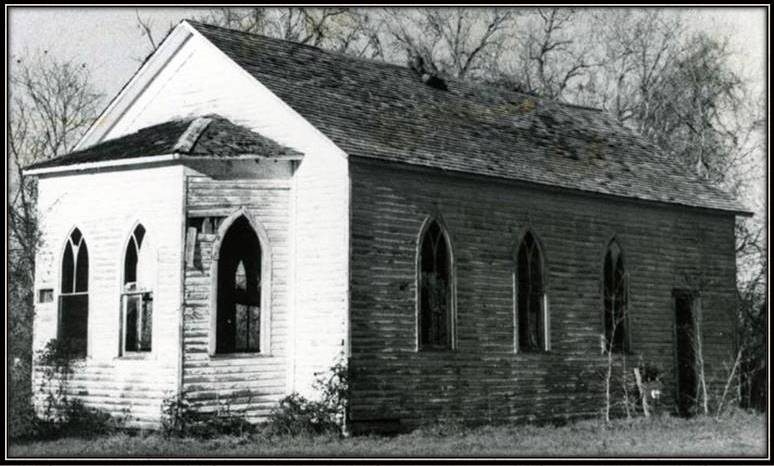 |
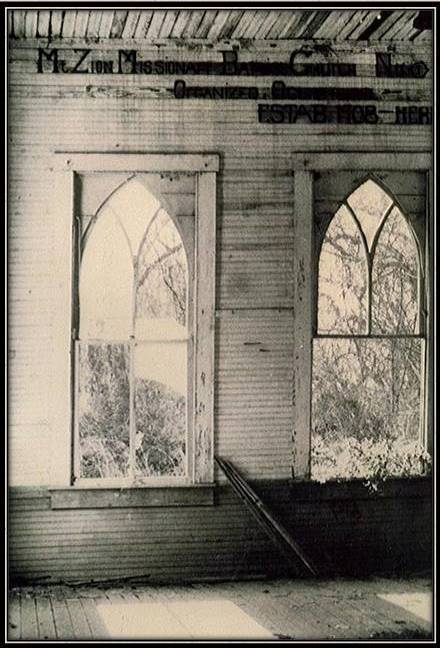 |
But my people most were Baptist and we’d go to church in Sweeny or wherever the meetings was. Revival meetings. They could have been in Old Ocean or Bay City and so forth. But I have people buried, Grandmother Creel and many relatives buried in Sweeny Cemetery.
PETTUS: Okay. So you didn’t go to a regular church, just wherever –
BAKER: No, that’s what I’m a little bit reluctant to tell you but you may find good humor in it. Most all of my people were Baptists and I was nurtured in the Word and the admonition of the Lord and if I told them I didn’t feel like going to church or Sunday School, they didn’t say much. Momma just got out the caster oil. And she didn’t have to do that many times until I was right ready to go. But most of my people were Baptists, all Protestants. In my early years and after I moved to Angleton my people were liberal enough to let me go with a little friend to the Presbyterian Church. And Brother Freeman was preaching strong on Missions. Missions and giving and helping the poor, the needy and talking about the hunger and the need in the world. He reached in his pocket brought out a quarter. My eyes got big, he says, if there’s anyone in this congregation, if there’s anyone that’s in the sound of my voice that needs this quarter, please step forward. Who do you think stepped forward? _____. Well, when my momma heard about that, she says you can’t go back there anymore. So then I went with a little friend to the Methodist Church. But I just fell in love with those dear people there and had classmates and friends there. And so, one day I went home all aglow. You know about the inner glow?
PETTUS: Yeah.
BAKER: And mother said, Peggy, what happened? I said, well Mom I might as well tell you because somebody will. I joined the church today. Oh, wonderful, child, I hope you make a good Baptist. I said, I’m a Methodist. Oh, I thought she was going to kill me. And her hair began to turn white. But God knows what He’s doing when he brings a person forward and calls them to His presence and to His altar. Because He knew all the time I was gong to marry Ross Bryan Baker and he was a Methodist.
PETTUS: Okay. Let’s get back to Hasema for a minute.
BAKER: Now, I asked my dear aunt, mother’s sister-in-law, what she could remember. She’s 95. She was 95 April. So she’s past 95 now but I found her invaluable information on this matter and she said, Hasema, she feels like was founded after World War I and she says approximately 1919. After World War I, you see. (Earlier than 1919)
I said, well, and she was Novella Starks, married Barney Creel, mother’s brother. The Starks, Mr. George Starks built the house and the barn on this site where I was born. The Starks, in other words had lived there before we moved, my family and my birth, you see. The house is no longer there. I’ve asked others. I don’t know whether –they moved the depot. They moved a lot of properties down there but I know the depot was sold but the farm and I showed you pictures of it, the last time I seen the site of the old farm was still standing. There was a depot.
PETTUS: You were telling a while ago about how impressed you were at what the depot –
BAKER: It was so neat. Now, the depot was just a short piece from where the house where I was born. So it wasn’t like a long venture. But I did want to tell you that you could hear the train at Hasema before you could see it because from the depot and to very nearby was ____ (Linville) Creek and the trestle. And you hear it before you could see it. But you got your flag ready. You got mother’s white cup tile or you got your white handkerchief if you’re going to stop or flag that train. You have a passenger or need that old train to stop, we stopped her with the –just wave the white flag.
PETTUS: Would you be at the depot when—
BAKER: You’d be at the depot and out on the platform. I remember there was a kind of a platform there. We faced it. You wouldn’t step beyond that platform. And then if there was any mail the postman on the train in that day, and they did it all over this great land, the train wouldn’t have to stop. He just caught it in a net, somewhat like a butterfly net.
NOTE: How it was probably done
But when I was older and when the grandparents, the Creels, still lived in Hasema but we had moved and I’m I grade school I could still go down to the Angleton depot , I believe it was a quarter and ride the train from Angleton to Hasema. And everything was going just fine until Granny and I rushed to meet the train, time for Peggy to go back home and to school. And I had a little white coin purse, little white coin purse that I kept my coins and my fare in and I rushed to get down to the depot to flag the train. I was on that train, David, it was down the track and the good byes were said and the conductor. You know how the conductor will come through and collect the fares. He got to me and where’s my little purse? That purse is nowhere. And I said, oh Mister, if you won’t throw me off of this train, my daddy’s going to meet this train and he’ll pay you. And he said, that will be fine. We got to Angleton depot and daddy had changed trousers, didn’t have his billfold. Daddy didn’t have no money either. Oh, and the depot agent, Mr. Earl Middleton said, I’ll take care of it. The depot – also there was a blacksmith shop, but I want to tell you first, I feel safe to say that the first recognizable site of some construction down at Hasema was the sawmill. Because they had to saw the logs, the lumber to build al of the houses and other structures down there at the bridge. At the old wooden bridge, rattle, rattle, rattle. I wish I had a photograph of that. Some nostalgic and our house was close enough to that old bridge that I liked the rumbles. That old bridge rumbled when people crossed it. But it’s wagons and teams.
But the sawmill was Mr. George Starks that build the home and the barn at the site. He was also foreman at the sawmill. Head honcho at the sawmill. And then we had the store was at Reeve’s property and home. And do you remember the Walton’s on TV? The post office was also—it had a little store, a commissary there and you must realize that the ___ of many people came to Hasema seeking houses. It was hard times. There’s poor and there’s pore and some of them were pore. And they came looking for jobs and whether it be on a farm or for a rancher. But many people began to come and settle there.
Now, did I explain that Hasema road – I’m talking dirt. I’m talking black gumbo. I’m talking, David, when you get stuck, man you are stuck. It ran parallel, the roads ran parallel with the Hasema road but there was one place you had to cross, about five miles or less down the road from Hasema you crossed over, if you’re going to Sweeney, you understand? Or Old Ocean, you crossed over the railroad tracks. And I advised you to stop back then at Mrs. Hallie Burts where they had a big artesian well and we would see –people stopped and visited back in those days. It was laid back. It was more laid back times. And everybody knew Mrs. Hallie. Now her grandson lived here in Angleton, Mr. Meter.
PETTUS: Her last name is ?
BAKER: Burt, Hallie Burt. Had a lot of children. I know she had a lot of children.
PETTUS: And she lived about five miles from Hasema?
BAKER: Uh-huh. And I don’t think less than half way—on the way to Sweeney. Back and forth. That negro black church* I mentioned too because it was in between there too.
*This could have been Washington Chapel Methodist Episcopal Church (1891) on Staggs Road which is still in use today.
And then now this is what’s called Route 2 (Now county road 322?), you know. We had the depot. We had the post office and the store, blacksmith shop and the sawmill. Oh, I didn’t tell you about the one room school house.
PETTUS: Yes, I was going to ask you about that.
BAKER: Now oddly enough it wasn’t right there near what I considered the original site, but you cross Limble (Linville) Creek and cross that old rumbling bridge and go down a piece, you can go straight ahead and you go to Allen Hurse, you can end up in Matagorda County. But right away if you cross over the railroad tracks again –you got it? Just a short piece there was the one room school house. And they tell me – I’m looking now for the first teacher. I’ve got it written down here. The first teacher, I’m told, in that school house at Hasema was Mrs. Ireland. And the teacher that I knew and loved so local, Vadis, Maiden name, Underwood, later Richardson, and I knew her, see, and called her Aunt Bade because all my cousins, all the kids simply called her Aunt Beda ___ and I didn’t know until I was grown that she wasn’t really my aunt but was kin to my first cousin. Now, I was so disappointed to learn that there was no Santa Claus.
--but in that same line, but later know that she was and I’m gong to put in Later, just that one word to fit, later principal at Sweeney School.
PETTUS: You said that her maiden name was Underwood?
BAKER: Underwood.
PETTUS: Was she related to Hammond Underwood or part of that Underwood family, the original settlers here?
BAKER: I would think so. But I know the people in Sweeney and in Bay City and Bambreck (Van Vleck), but I didn’t tell you, the aunt, the one that run the school house, we’d crossed over the railroad tracks and beyond the one room school house and also down the road a piece were going towards – and Jay Mallard thought I was lying when I said, Buck Scuffle.
And you will find my cousin, daddy’s brother’s William Clifton Sewell (1898-1971) and his family, Joe Richardson (Benjamin Roe Richardson 1888-1929?).
I’m talking about uncles such as my daddy’s brother. I called him Uncle Lester. Lester and Limma and they had a large family. And some of their sons are still down there on those old estates and on that property.
PETTUS: Okay. About how big was that school building? Was it a – how large was the room? Was it the size of this room, do you think?
BAKER: Oh yes, I feel safe to say it, because the Houston in vision, I would think all over this land of the churches and the one room school houses have the school accommodate—they had not always desks, but benches and while the teacher would be teaching, maybe little first graders, the other would be busy over here at studies, and so forth. But I think they told me at Hasema School they could go probably to the first, maybe fourth or fifth grade and then they had to go to Sweeney or Bambreck (Van Vleck). You know, even some kids in that rural area they would go then. I don’t know how the boundaries or areas were designated but my cousins would even finish in Sweeney or Bambreck. Go to Bambreck (Van Vleck) to a certain age and you finish in Bay City. Cousins that grew up and went to school in Bambreck (Van Vleck) then finished high school in Bay City. But, see, that’s Matagorda County. But we were scattered. We were just scattered all over that rural area and then—oh I didn’t tell you too, about the-- I mentioned Mrs. Hallie’s deep artesian well, but the thing, I could still taste it, the cold, cold water.
 |
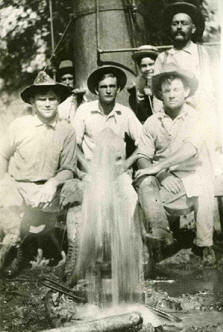 |
| Images courtesy of TxGenWeb site for Matagorda County | |
| This imay be the well or one similar in the area. People in picture unknown. There are references to artesian well(s) in Sweeny as well. | |
I’m talking the summers could be scorching hot and we’re talking about laborers and people working in the fields. Did I tell you about the tall cotton? And the tall corn?
PETTUS: No.
BAKER: It was fertile. That’s what brought my granddaddy there. He read about the fertile lands on the Texas Gulf coast and he always had, all my days, long as he lived, he kept talking about, Mammy, some day I’m going to go west. And look what? They just kept moving west. But anyway, it is very fertile land but he would say, when he decided that – he said, this black gumbo, meaning that fertile land, is breaking my ___and it’s breaking my mules down. It’s hard to work when it’s at a certain phase, but when it gets to a certain dry and it’s wonderful soil, but when it’s wet it’s like tar.
PETTUS: Yes, I know what you mean. I’ve worked in it too.
BAKER: Wouldn’t you know. But then my grandparents stayed there for a long time, but see, my mother, dad, moved from Hasema to Sergeant on the Gulf. And I can tell you he farmed there also, but from Sergeant on the Gulf we moved to Bay City and, David, when I was five years old, we moved to Angleton. –
START OF CASSETTE TAPE 1 OF 2, SIDE B
BAKER: We begin speaking of Hasema and cherish days and memories, I remember my first Christmas and everybody got excited and says, Santa’s coming, Santa’s coming! I thought it must be him in costume, but I thought it must be one of Santa’ helpers because the voice sounded an awful lot like Aunt Clarabelle. But, David, I was not disillusioned, no sirree, because I wanted to believe and it took them years to convince me that there was no Santa Claus, if you want to believe. And then another precious memory, I don’t remember whether I learned to walk. Incidentally, they said I was 13 months old before I decided to walk. They said, I wish I could remember but they said, I didn’t even crawl much. But you don’t have to walk, man, when they hand you and give you everything you need and want.
PETTUS: That’s right.
BAKER: But Granny’s old cat came in the room I’m told and I grabbed that cat by the tail and I reckon that cat just hoisted me to my feet and I’ve been walking ever since. And then I worried Momma a lot when I found my legs running off, running off. You don’t run from your momma. Because if she catches you, you’ll liable to get a whipping. It wasn’t child abuse then and we never lived anywhere Momma didn’t have a peach tree. That peach tree never stood a chance. She was pruning it all the time. She was pruning me all the time but she never did harm me much. But I learned to dance real pretty. It’ll teach you to hop, skip, and jump.
PETTUS: Yes, it will.
BAKER: But now, my daddy. I can’t remember whether I learned to walk or go fishing with my daddy. It all came along at the same time, about the same time. And of course he made a little tomboy out of me. And I just idolized him so. Now, my daddy never took no peach tree switch to me. He never did do it and some times he could look at me real stern. And I knew not to push my luck. But had it not been for Mother’s discipline, I know now there’s no telling where I would have been today. And so discipline is important. But anyway, here’s a picture of down Hasema way. Granddaddy’s old modal T and see, they’ve been fishing.
PETTUS: It’s a good fishing day. I never caught one that big in my life.
BAKER: Absolutely. And so we were near the Gulf, the rivers, and the lakes. They would take all day and go in their wagons and go down to the Gulf and off to the rivers and fish. And so much for that. But now, what else?
Oh at Hasema we didn’t have no swimming pools. There weren’t no parks and recreational facilities and such. See, Uncle Burney swimming in the horse tank?
PETTUS: Yeah. I want to ask you a little bit more about Christmas. Did you celebrate Christmas like they do here now with decorations and --
BAKER: We went out and cut a wild cedar. We went out and cut—now, that’s delightful. For parents or grandparents to take you out and cut and let you choose, the family, the made up selection and cut the tree. Now, we didn’t go to the store. We didn’t –there was no store bought ornaments. We strung popcorn, alright. And we used just the things available at home. Now this helped to create creativity. If we had an angel or a star on top of the tree you can know that some creative helpful hands in that family created it, those ornaments. If they had treasure—old wooden, wooden ornaments and they’re popular again. Ornaments such as wooden and cherry things that last. Ornaments made with tatting or crochet, needle, needle craft, tied to ornaments.
PETTUS: I’ve heard of things like that but I’ve never seen the real thing.
BAKER: And cookies and lighter sweets and nuts. But no store bought stuff. My dolls—when I played dolls it might have been a little sock or rag doll. Mother played with corn silk dolls. Do you know, I bet the Museum has some corn silk dolls.
PETTUS: No, I didn’t know that.
BAKER: Corn silk. They take the corn husk dolls and the hair would be of corn silk. Can you visualize?
PETTUS: Yes, I can.
BAKER: But some of my dolls were socks, the fabric and then the faces would be painted –oh Mother’s sister married a full Dutch. When they went back to Holland they brought me a beautiful China doll. Those are cherished too. I bet the Museum has some. The heads are China and just decorated so beautiful. Now that was in my early days.
PETTUS: I guess ya’ll had a fixed Christmas dinner?
BAKER: The dinner, it took days. There was no easily prepared foods. No frozen food. But you see, I’m from an agrarian family and so the cattle and the food. Most stuff was raised mostly we only went to the store to get staple groceries. When I first married Ross I went out and bought a ten pound sack of flour because that’s what Granny had done. That’s too much for two people, you see. But the staples that they raise I watched granddaddy butcher and clean the wild game. I also remember granddad having come from Mississippi he always had a little small fruit orchard. And that might be plums or peaches. He had what would be more than just a few fig trees. It could be called a small orchard down there at Hasema. And in my minds eye I can see all the big beautiful trees and grasses and wild flowers, you know, you can’t beat Texas for wild flowers.
PETTUS: That’s right.
BAKER: And the palmetto, those are quite useful too. It’s hat palmetto palm. And I’m sure it’s running wild down there today. And we could cover, make thatch roofs and little arbors. And things like that, with that palmetto. And the Spanish moss. I have friends today up north and out west ask me, Peggy, does the Spanish moss still grow on the trees down south, because they loved the Spanish moss.
PETTUS: Yes.
BAKER: It’s so picturesque. But there’s just so much in my heart, David, and I think that the times I might have been a very protected child because I made it during the depression, the great depression, I remember seeing one man cry but I didn’t know why. And their hearts were broken because times were so hard and they couldn’t survive. That’s why people all over Texas in this great land moved so much. They were trying to find prosperity, trying to find jobs. And they went, you know back in boom time, all over Texas and throughout this land boom towns would spring up. And people would follow that information and moved a lot. But transportation was slow. So back then it wasn’t as mobile as a society as we remember today. Because transportation wasn’t so fast. I remember the first automobile I ever saw was in Hasema. And the Dutch Uncle Fred ____ drove up to the courthouse gate and your Museum has a picture of it, of that automobile, somewhere I showed you. But the Museum has a picture and I believe that’s my uncle Lloyd. See the flatbed wagon and the mule team? Now, that was good transportation. And granddaddy had all his mules and horses had names. He talked to his horses. He talked to his cows. Granny talked to her chickens. And one thing else, if I may, I thought it was a special lark to go get the eggs for granny and do the chores. I didn’t know no better. But I went out there to the barn, you see, to gather some eggs for granny. And I reach in that hen nest and there’s a chicken snake. I never did think it was a special chore anymore. Now, it’s no fun to go gather eggs and find the chicken snake.
PETTUS: That would be the barn in the pictures?
BAKER: That’s right. And from an aerial view we can’t drive down there any more and these pictures, but you could from aerial view or maybe from the railroad tracks. Missouri-Pacific is not Katy, but we can’t drive back. You’d be trespassing and the sign says now, "No Fishing, No Hunting, No Nothing". They want you to keep out but they can’t keep it out of my heart. And they can’t keep it out of my mind. The pictures of Hasema and the loving family and friends and relatives there. And you see, to me, the first institution God planned is the home and if farmers couldn’t make it to town, couldn’t make it to church, granddad and then my both granddads were both somewhat like lay preachers. And granddaddy Sewell played guitar and the instruments, oh the Juice Harp (You know what a juice harp is?) and the harmonica. All you need is the pitch and on the front of granddaddy’s house was a veranda, a porch where you could go out there and catch the breeze, no matter what, hopefully, if there was a breeze coming from any direction. And I could remember ____ sitting on the top steps just looking up and admiring and idolizing him so and granddaddy Sewell may preach a little Gospel and then he’d burst into song. And those old songs still bring true and still ring in my ears.
PETTUS: What were some of those songs?
BAKER: Well, "Beulah Land", "Sweet Bye and Bye". Oh honey, "When the Roll is Called Up Yonder". When the roll is called up yonder I’ll be there. Oh precious songs. "Sweet Hour of Prayer", "In the Garden" and one of my favorite ones, "I Love to Tell The Story". And "How Love Lifted Me". It’ll lift us today right out of our blooming ___.
PETTUS: We sang that every Sunday in Sunday School.
BAKER: Another, "What a Friend We have in Jesus". That’s a good doxology. ___ to sing it, but people need to know that no matter what serious experience they’re facing they have a friend. Are we preaching?
PETTUS: I don’t know.
BAKER: You go get Mike and we’ll pass the coffee. Are we having fun?
PETTUS: I think we are. I think we are having a lot of fun here.
BAKER: Now, I didn’t get to show Jamie, here’s Hasema. I mentioned old Bear Camp, didn’t I?
NOTE: Many people went to the Hasima woods to camp out & hunt for bear. Also in 1926 a man named W. I. Shotwell ran a hunting preserve off Boone Settlement Road by Old Ocean Swamp. See map at beginning of article. See article about some of Peggy's Sewell & Richardson relatives killing a really big bear in 1915 which made the Bay City newspaper. here
PETTUS: Yeah.
BAKER: That is Peggy Jean still a little crawling baby. Hasn’t found her legs yet. This is Hasema and that’s me. That’s me on that bear skin rug at granddaddy Creel’s. There’s the old vehicle. Look at those clothes. That’s mother and daddy. Nothing fancy, but I imagine they’re dressed to go to church. And a fact he doesn’t have a coat. Got his tie on. But he doesn’t have a coat. It’s probably summer time. Oh yes. Well, I just get so excited when – you see, David, Shay Mallard heard me at a meeting here mention one time Hasema and then I went on and somebody said, well, Mrs. Baker where is Hasema? I said, of it’s right down there at Bucks Trussle and Jay Mallard said, she’s lying. And he didn’t believe that there was no such place. And it’s true. It’s true, David. To my disgrace, Hasema was really never a dot on the Texas map.
PETTUS: But they did have a post office.
BAKER: They had the post office and they had the depot big as life. It said "Hasema". Another thing, fascinated me before the train left Hasema was down there you stop to get gas (Water…. steam engine) out of that big old cistern thing. And that fascinated me too. And did I mention the train? One thing I would never be able to forget. Did you ever have a horse run away with you?
PETTUS: No, no.
BAKER: Well, let me tell you. It’s scary. And I was so little. Now, they saddled me up on my favorite mare, Dolly. Dolly was gentle. She was the sweetest mare. And I was so little, you see, my feet wouldn’t even reach the stirrup. But I’m just taking it easy and old Dolly and I just walking down that Hasema road. I thought minding our own business, having a good old 37
time. And that train whistle blew. Man, Dolly flew. I thought. I thought she was going into orbit. And can you just vision me bouncing in that saddle, holding on to the brains and the pommel up front. Whoa, Dolly, Whoa Dolly. Whoa Dolly and I don’t know when she finally wound down and stopped I think half way to Mrs. Hallie Hurst. But that didn’t stop me from riding because I sent out riding with granddaddy Creel. All my life I’ve loved animals. You like animals?
PETTUS: Oh yeah. I like dogs. I’m not much on horses, but cats and dogs I’ve had them.
BAKER: And pets and children keep us humble. Keep us generous and humble.
PETTUS: About how many families, people lived in Hasema?
BAKER: I asked my aunt, Novella, that I mentioned and it wasn’t a big population, but see, some would work at the sawmill. Not everybody that would work on the farms, at ranching, cattle driving and such as that, lived in Hasema. But in that area –
PETTUS: The general area there?
BAKER: They came from Old Ocean or Sweeny and so forth. But I know that many of the old time families and residents, old timers, original families are buried in Swenny, Baumblack (Van Vleck), maybe Old Ocean, you know. And those cemeteries, that’s another topic for you. It takes too much time to tell, but much solid information can be found in the cemetery on the people.
PETTUS: You probably know that the Museum has a very active cemetery committee. And they’ve recorded information on all the cemeteries they can get to. There’s a few that are on private land and the land owners won’t let them. It’s against the law but they can do it them anyway. Yeah, the cemeteries are good sources of information.
PETTUS: When you moved to Angleton.
BAKER: I was five years old. You want me to tell you what I remember seeing?"
Interview continues on about her life in Angleton. She died in 2012 and is buried in the Angleton cemetery. Her obituary with more details on her life can be found here
The complete transcript is available at Brazoria County Historical Museum in Angleton.
Memories Part II
In 1990 Bertha Louise Sewell Hanna Norman wrote a family story about life in Hasima. The family was kind enough to allow us to share excerpts.
Credit to Velma Smith whom put together the booklet from her grandmother Bertha's memories.
“Sunday Best”
As written by
Bertha Louise Sewell Hanna Norman
I chose the title "Sunday Best" because so many of my fondest memories are visits to grandma's house on Sundays, from breakfast sermons on the ills of sin from Grandma Sewell ("Little Grandma" when we were smaller) to the best baked goodies in the world from Grandma Bert. There is a peace to be absorbed when one enters the old home place.
Perhaps it comes from years of love poured out with no thought of the well running dry. So many have passed through that house. However, I really feel that it is Grandma and her absolute acceptance and love for everyone that comes through her door.
MY PARENTS
My dad was named George Thomas Lester Sewell. He dropped the Thomas in later life. However, it is on his marriage license. He was, I'll say the youngest child of twelve. He had a twin brother, Oliver Felton Sewell, who died at eighteen months. He was a man who loved his God, his family and his neighbor. All the nieces and nephews loved him. They called him Uncle Let. Tennessee Ernie Ford didn't have anything on Dad when it came to singing bass. His two older brothers also sang. Uncle Will sang tenor. Uncle Jud sang soprano. There was an older sister who sang alto and played the organ. Music was a large part of our upbringing. Dad sang in the church choir. Dad was a deacon of the First Baptist Church in Sweeny, Texas. He loved to swim and play in the water. In October before he died, he carried the grandchildren to the Old Ocean pool, came home, cut off the legs of an old pair of overalls, went back and dived off the diving board. When news came that he had died, the neighbor boy said, "I can't believe that. It hasn't been that long since he was swimming with us.”
My mama was named Lemma Agnes Richardson Sewell. She was the fourth child of Benjamin and Hixie Adella Meadows Richardson. Mother was a workaholic. She helped her mother raise the younger children. At fourteen years of age she was sewing for the family. In 1910 or 1911 she took a correspondence course in sewing. She made a 98 on her lesson. Faye Pounders has her lesson book. Somewhere in the area of 1916 or 1917 there was a mother in the bottom that lost her baby at about seven months. It was born dead. My mother took a boot box and made a coffin, lining it with satin and lace. I was so shocked that she had those kinds of materials in the house. During the year that they lived at Chance's Prairie she had sewn for the colored women. The coffin was a beautiful box to me. The men folk made a pine box at the black smith shop. They carried the infant in a buggy to Sweeny where it was buried.
THE BAYOU
My story begins on the banks of the Linville Bayou. As a child, we called it "the creek", but the deeds say Linville Bayou. This waterway begins somewhere in Wharton county and winds its way toward the Gulf until it empties into Caney Creek in the Bell Bottom community. It is the dividing line between Matagorda and Brazoria counties.
This was our playground as children. Some places had deep holes that we fished and learn to swim in. Others places were shallow enough to wade. We also hunted along this waterway.
In 1913, someone dammed it up and tried to grow rice. This attempt failed. Someone dynamited this dam. I strongly suspect some of my young uncles were guilty. This made the best swimming hole ever. Here is where my dad taught all five of us kids to swim as well as many of the nephews and nieces and Aunt Maggie. Farther down the bayou was a deep hole called the alligator hole. This was a fancy fishing hole. We caught bass, goggle-eyed perch, catfish, and eels.
Two or three miles farther down was the bear camp. Every November, on the fifteenth, the well-to-do men from Brenham came there to camp and hunt for two or three weeks. Sometimes Uncle Bob or Uncle Joe was the guide. Whether they ever killed a bear or not, I do not know. This continued until December 1934. This year it was raining every day and the mosquitoes were terrible. The roads were almost impassable; ruts
everywhere. When they came out of that bottom, they did not have their hands on the steering wheels. They were fighting mosquitoes. The ruts were so deep the old cars were going right on. They never came back to the bear camp.
I was not conscious of the bayou until 1916, when I started to school. We had to walk a mile and a half to get to school. When the bayou was up we had to cross in a row boat. Then we had to cross Little Linville in a row boat as well. The bayou had beautiful cypress trees all along the edge of the water. Now all of this is gone and sometimes it is so dry you can walk across. It is so polluted that terrapins are all that live in it.
During Prohibition there were quite a few stills on the bayou.
THE SCHOOLS
The first year I went to school at Hasima I was seven years-old. That was the beginning age then. The school was upstairs in the store building. The post office was on the bottom floor. This was a country store. You could buy anything that a person needed: A plow, groceries, cloth. Crackers, for instance, came in a barrel and you bought them by the bulk.
Uncle P.J. Reeves ran the store. Aunt Maggie was the Post Mistress. Our teacher, Miss Hattie Bronson, was from Angleton.
I will never forget the first Christmas tree I saw. Uncle Joe and Uncle Bryan cut a Holly tree off our land and hauled it one and a half miles in a wagon to the school. It reached to the nine foot ceiling. It was covered with red berries. For a week we had made paper chains and strung popcorn to put on the tree. Apples and peppermint canes completed the decorations.
The second year of school was in Grandpa and Grandma Richardson's parlor. Desks were placed in the parlor. Our teacher was Miss Bell Brigham from Bay City. This was in the fall of 1916 and the spring of 1917.
In the fall of 1917, the school house was finished and ready for school. It probably was about a half mile from the Bayou, about a half mile from Hasima, and about a mile from where we lived. This was so it would be about an equal distance for all the children. It was not any more than fifty feet from the St. Louis, Brownsville, Mexico Railroad.
In these days there was no stock law. Everybody's animals ran loose. So, the railroad was fenced on both sides to keep the animals off the tracks.
The ditches on each side of the railroad were full of water. We sometimes fished in them. I will relate a story about that later.
Miss Eddy McLendon from Bay City was the teacher.
Our next teacher was a Mrs. Ireland from Houston. She was something else. She boarded with three families before throwing in the towel and going back to Houston. She only stayed five months. Then in the fall of 1919, Miss Vades Underwood became the teacher. She taught me from the fourth grade until I finished the seventh grade. In those days, when you finished the seventh grade, you were ready for high school.
She married Joe Richardson. In 1921, she took a year off. This is the year that Joyce Richardson was born.
Miss Mary Bacon was the teacher that year. I finished the seventh grade that year. Vades Richardson continued to teach in Hasima until about 1936. My sister, Hixie Sewell, then taught two years. The school was then transferred to Van Vleck.
One time at the noon hour, we kids found a coach whip. This is a big snake. We chased him into a hollow log. We finally killed him and carried him to the school house. Aunt Vades measured him. He was nine foot long. He was a beautiful tan color.
THE FAMILY FARM
In 1909 my Grandfather Richardson bought 100 acres of land within a quarter mile from the Linville. My dad and mother's brother Roe bought 50 acres in 1911, paying $17.50 per acre. This was virgin land, jungle almost. Liveoak, pinoak, elm, ash, pecan trees were abundant. The underbrush was wild with peach, yaupon, rattan vine, and blackberry briars.
It was infested with every kind of wild animal common to south Texas, bears, panthers, bobcats, deer, squirrel, opossum, and racoons. We had all five of the poisonous snakes, rattlesnakes, ground rattlers, copperheads, cottonmouth water moccasins, and coral snakes. One morning, as Dad went out to feed, he met a chicken snake that had swallowed two goose eggs. Dad said he looked like a dromedary.
The houses were built and both families moved in on Thanksgiving Day of 1912. My grandparents house was a story and a half high. There was a double fire place, one in each of the two rooms. The stair well was really steep and opened on to the porch. Granny would tell us kids that Red Eye and Bloody Bones lived up there. This was to scare us so that we would not go up the stairs and fall. Upstairs was one big room. This is where the boys slept. There was a half bed there that a colored boy slept in. He worked for Grandpa from 1911 until he left to serve in World War I. The kitchen was twenty feet long and probably twelve feet wide. The old cast iron stove sat in the comer. It was huge with a warming closet above the stove and a hot water reservoir on the side.
The dining room table was huge with a bench on each side. On holidays the oil cloth was removed and a beautiful linen cloth was put on Grandma would cut oranges to look like flowers to decorate the table. She would also scatter candies around and mold butter to resemble flowers and animals.
Christmas was really special. All the family went to Grandma's, our house, or Aunt Maggie's. My dad and Aunt Maggie would play anti-over with us kids if the weather permitted. Aunt Maggie played the piano and we sang hymns.
Grandpa Richardson never had much foolishness about him. He never played any games except croquet He always had a beard. One day he went to Bay City, had a haircut, his beard shaved off, and bought himself a cap. He walked up the road through the settlement and none of his kids knew him.
Grandma was so full of fun. She crawfished with the grandkids, carried them squirrel hunting. She also kept a safe full of tea cakes. She chewed Brown Mule tobacco and dipped snuff. Her hair was always neat. She had a white bonnet for Sunday and a white apron starched and ironed to a "T." When she went out she powdered her face and wore beads. She was a "Southern Lady" by all standards.
CHILDHOOD ESCAPADES
` One year, before I started to school, Briten and I got a red wagon for Christmas. Sometime the next week, I put a rope around the calf that was in the cow lot and tied the other end to the tongue of the wagon. I got in front and Briten got behind me. The calf was so scared it ran for about twenty feet and went between the barbed wire and hog wire fence. When I saw it was going through the fences, I jumped out. Briten sat there like a dummy. Fortunately the front wheel hung on the hog wire and he was not hurt. When Mama got through with me I wasn't not hurt. I can still feel those peach switches.
About the time that I was six, Briten was four and Madeline was two, on a summer day, we decided to take a swim in the hog waller. So, we shed our clothes and waded around in the waller. Mama said she looked and could not think where three colored kids had come from. Boy, we never tried that again. She sure could use a peach tree switch.
In those days there were no screens on the windows. The flies were terrible. Mama kept fly paper called Tangle Fast out. It was about three feet long and about eighteen inches wide. It was sticky and I mean sticky. Mother had placed one in the living room when an old rooster came in the house. Just before this she had switched all three of us and told us if we did not hush she would do it again. Well, we weren't really ready to hush, so we went out under the big old fig tree that was in front of the chicken house. She threw the broom at the old rooster and he landed on the fly paper. It flew up and caught him on his tail feathers. He couldn't walk. He jumped and every jump he made he squawked. We jumped up and forgot about our mad and laughed.
The year Mrs. Eddie McLendon was teaching I was in the third grade. We had some boy cousins living at Hasima proper, John, George, and Edward. If John was not in trouble himself, he had someone else in trouble. He came to our house one Sunday afternoon. He was so tickled, he said that Aunt Maggie, Uncle Bob, and Eddie Porter (Eddie was Miss Eddie McLendon's boyfriend) had tin canned an old horse. The settlement was full of stray horses and cows. So, for entertainment, people would catch a horse, tie a tub on his tail, fill the tub with tin cans and then turn the horse loose. The animal would go "bananas" as the kids say today. John had never seen this done before and thought it was great fun. Ms. Eddie had turned school out at noon every day for a week and gone squirrel hunting with her beau. So my mother said to John, “I guess we will have to "tin can" Mr. Porter so Miss Eddie can stay at school all day. Mother was disgusted because she had fixed us a lunch, then we would be home by 12:30.
John met me before we entered the school house Monday morning. He said, "Bert, I will give you a dime if you will tell the teacher what your mother said." Dimes were few and far between, so I told her. She tanned my bottom good. I knew better than to bring the dime home, so I went to the store and bought a dime's worth of crackers. They were sold by the bulk, so I had enough crackers that everybody that came to Buck's Scuffle had all they wanted to eat. When I got home my mama gave me another tanning. I told her that was one whipping I did not need. I got the job done. Miss Eddie taught eight hours after that.
Back to the bar ditches by the railroad...John showed up with a bent pin, was fishing where the water went through the culvert where the road crossed the railroad. The water must have been about three feet deep. There was this girl from our community named Viola Bankston. She was an only child. The next day she showed up at school with a cane pole and a fish hook. When school was out she baited her hook and set out her pole. The next morning when we turned the corner, there the three Meadows boys were, hollering for Viola to hurry as there was something on her hook. We ran for our lives. When we got there the fishing pole was going up and down. She jerked it up and there was a ball of green moss on it. She got so mad, she started screaming, hollering, and beating those boys with her fists. Miss Eddie had not arrived, but she was close enough that she heard the noise and it really scared her. She ran as fast as she could and when she found out about the teasing, we had to write 500 hundred times, " I will not tease in school."
During the time that Miss Ireland was teaching a family moved into Hasima with a boy about two years older than I was. She sent him to the blackboard to write his spelling. She told him to write gravy. He wrote "grave." Every time he misspelled it. Finally she said, "That is where you are going to go if you don't quit smoking those cigarettes," and then she whipped him with a switch. He really spelled it correctly then.
Mrs. Ireland was boarding at Grandma Richardson's. She had a four year-old boy which Grandma kept while she was at school. She went into Bay City one Saturday and bought him a pair of overalls. When she put them on him, she put them on backwards and sent him in to show Grandpa.
The roads were terrible. The loggers had hauled live oak logs to the saw mill at Hasima. One evening Mrs. Ireland got in one of those ruts over her boot tops. It took Briten and I both to pull her out.
She would never say the boar hog. She would always say the man hog.
THE BEAR HUNT
In the early part of May it had rained so the men could not walk in the fields. Granddad was still farming cotton at Chance's Prairie, so several colored men with their sons came down to go deer hunting. In those days there was no season, so if you wanted venison, you took your gun out and shot one. They brought their hounds. All of my uncles and dad had at least two hounds.
The dogs jumped a bear. I was scared to death because my dad was back there. We could hear the dogs barking, guns shooting, and men hollering. This went on for hours. Finally, about five o'clock. Uncle Roe came and wanted us to go to Granny's to see the bear. Uncle Bob said he had shot all his buckshot and he was worried about his dogs. They had the bear bayed. Finally Joe Wade, a colored man, arrived. He gave Uncle Bob his gun and he finished the bear off. When the young men in the hunt heard they were after a bear, they all climbed trees. Someone came got Ada, a big old Missouri mule. They had to cut a trail for her. The bear was loaded on her. While trying to cross a log in the trail, she fell down, lost the bear and they had to load him again. Anyway, when we got to Granny's they had the bear standing up with his nose resting on a potato basket. Mother and I were sitting on the porch and every old hound was facing the bear. All at
once the bear fell over. Mama and I almost tore the door off getting in the house. The hounds all yelped and ran under the house.
Sometime in July 1916, Uncle William Ciciro Sewell came to Texas. He had five children. Myrtle 19, Clifton 17, Elmer Lee 15, Bernice 12, and Cora Bell 9. Things began to pick up for the young people in the bottom.
At Christmas that year, there was a dance at Granny's house. We shoved the dining table against the side table and removed the benches. Granny threw freshly ground cornmeal on the floor. A fiddler by the name of Mr. Bailey provided violin music to dance by. After about three sets, you were hard put to stay on your feet. The next morning I helped Granny sweep the floor. The heart pine floor was polished until it was shiny.
I was not much interested in the dancing, so I followed Uncle Rod outside. He was a little odd. I f he ever had a girlfriend I do not know about it. He liked to play pranks on the other boys. He knew Uncle Bob had a date to see Myrtle Sewell home and Uncle Joe was to see Miss Hallie Bronson back to her boarding place. He sawed two spokes out of the back wheel of the surrey (two seated buggy) almost in two. They got about a mile and a half down the road and, of course, the wheel broke down. They had to walk a mile through the woods and muddy road. He told me that i f I told what he had done he would give me a whipping. I never told it until after he died.
Back to the bears….. In the spring of 1917 Uncle Bryan Richardson set a gun in the fence. I do not know just how they did that, but somehow the fence hooked to the trigger of the gun. They found a place in the fence where the bear entered and set the gun there. Anyway he killed two bears that night, a mother bear and a half grown cub. He dressed them and caught the evening train to Houston and sold them to the restaurants for $25.00 each.
Shortly after this, Dad was going to set a gun one evening and mother went along. She was carrying the gun he was going to set and he had a gun with squirrel shot in it hoping he would get a mess of squirrels for supper. The winds were blowing awfully high and they walked up on Mr. Bear in the corn field. The old bear threw up his head and Dad shot him in the throat. He wheeled and ran and Dad shot him in the rear. Dad was so excited that he forgot that he had shot him with fine shot. They trailed him for several miles back into the woods, but never found him. We always knew when there was a bear close at night because the old mule, named Tom, would pace the lot and snort.
One afternoon Cora Bell came home from school with us to spend the night. Late that evening Cora Bell, Briten and myself went across the road into a small clearing where we knew there was a blackberry patch. Briten and Cora Bell went on one side of the patch when we heard a terrible growl. I flew around to where they had been and they were already heading for home. I did not tarry either, I said, "What are you all trying to scare me for." They said it was not them. The next morning when mother went to pick berries, all the briars were wallowed down. If he was that close, that is the closest I ever was to a live one.
The last bear I heard of being killed was in 1926 in the Cedar Lane woods.
SPENDING MONEY,
THE WILD WOMAN OF HASIMA
AND PANTHERS
My uncles use to catch bullfrogs and sell them to the colored porter on the train. They got $2.00 per dozen. I have no idea what the colored man got for them.
In 1926, on the fourth of July, the news broke. Will Underwood found a nude woman in the Bear Camp woods. Whether there was really a woman there, I do not know, but there was someone. I now believe that it was a convict hiding there out of the way. The people of the surrounding area spent three weeks hunting for this person. Uncle Bob and Grandpa Richardson said there were someone there who had a narrow and small
footprint.
A man came from Louisiana and spent two weeks camped there. His daughter was missing. He was looking for her. The person was never found. I have wanted to check the Bay City Tribune. I know the story was in the paper and I just do not know how to do it.
In 1929,I lived in Uncle Roe's house where Bernice now lives (Grandma wrote this before Aunt Bernice died.) The men folk hunted racoons and opossums for their hides to sell for spending money. No one had any cash and a coon hide would bring $5.00.
Voyd had borrowed my Dad's hunting dog named Jack. He would hunt for anyone. Anyway, he got up at three o'clock to go hunting and he did not stay long. He said, "Old Jack just won't hunt. I couldn't get him to leave me." That night when Voyd was outside and I was in the kitchen we heard the most awful scream. The hair rose up on the back of my neck. It screamed the one time and we never heard it any more. Voyd came in the house and said, "Now I know why Old Jack wouldn't hunt this morning."
In 1932, I was living in Uncle Bryan's bam. It had been a two room house at one time. The men folk hunted rabbits at night. One would drive the car and one would sit on the hood of the car. They would shoot the rabbits by the car lights.
Voyd was driving our old car and a colored man named Sidney was sitting on the hood. Sidney's wife was sitting just outside my door when we heard this awful scream. Ida Mae said, "What was that?" It screamed again. I said, "Ida Mae, get in the house now." We locked the door. It screamed one more time. The men made fun of us. They didn't believe us. I know it was a panther. Different ones have seen it at different times, G. W., Wilburn Richardson and Uncle Bob Richardson.
1940 I remember so well because Phyllis was born that year. The deer hunting season always started on the fifteenth of November. A week or so before the fifteenth, dad's old sow broke out and was gone for two days. She had eight weaning size pigs. When she got home one of the pigs was missing. Dad could not figure it out what was happening, so he put the old sow and the remaining pigs in the mule lot which had a shed the length of the bam. One half of this shed was boxed up waist high. This was where he put the sow when she farrowed. He locked them up Saturday evening. Sunday morning, when he went out to feed something had killed another pig. It had eaten the bone, but it had been skinned as well as if a butcher had done it. It ate all the pig but about half of one ham. That Sunday marked the beginning of the hunting season. A bunch of hunters came in behind where we lived, so whatever was catching the pigs moved down to Joe Wooley's place and got a pig there. Since it seemed to come every other night, Mr. Wooley stayed in his barn until two o'clock that night. He gave up and went to the house. It came and got a pig. I could not swear that was a panther, but everybody thought so.
Family
I was born Bertha Louise Sewell on September 30, 1909 in Bay City at a place where Cherry Elementary is now. I was a year old when we moved to Old Ocean. I can't say that I remember anything about Old Ocean. However, there were things I do remember and Mama has said that it happened in Old Ocean. In those days it was Chance's Prairie.
I was at Granny's house and chasing her puppy around the dining table. I knocked the bench over and it killed her puppy. I went home bawling, “I am sorry I killed Granny's puppy." I had a mate to it and was going to give it to Granny. When I got home Mama had given my puppy a bath in tobacco juice to kill the lice on it. This had killed my puppy.
I was at Granny's when Uncle Joe fell off the roof of the porch and broke his arm. The doctor came in a buggy.
I remember sitting on the porch in a rocker with Uncle Mose, a twin. We were really rocking. I now realize that Uncle Mose knew that old chair would rock off the porch, but I didn't. Finally chair, Mose and me went off the porch. I still remember how I cursed him.
I was the oldest grandchild and those boys really spoiled me. Oh, I did love those uncles.
James Briten Sewell was born October 4, I911 at Chance's Prairie. I don't remember him as a baby.
Madeline Sewell was born October 12, I913 here where I live now and I do remember her.
In 1913 the big flood came in December. Therrell Reeves was born the twelfth day of December and Mama was staying with Aunt Maggie. Dad went to get Mama and Granny was going to stay a few days. Old Linville was spread everywhere. We had to cross a drainage ditch that emptied into the Linville. We were in a hack, something like a buggy without a top. About a quarter of a mile up from the creek, Dad said, "Mrs.
Richardson, put your feet on the seat so they won’t get wet.” The mules had to swim. Granny screamed and hollered the whole time we were crossing. When we got to Aunt Maggie's, Uncle P. J. Had killed a big timber wolf that morning. Lurline and I was looking out the door. Somehow we both fell out right on top of that wolf. It liked to have sacred us to death.
The younger people have no idea how primitively we lived. Sometimes we had to put four mules to a wagon to get out of the bottom. One time Hixie took a high fever. Dad brought the doctor in on a slide from the highway. When he had doctored her, Dad carried him back on the slide. At that time there was a telephone at Hasima. In 1921 the nearest telephone was Sweeny.
On November 3, 1918, George Richardson Sewell joined our family. A cousin, Ruby Richardson, was born September 20, 1918 and another cousin, Wilburn Richardson, was born November 17, 1918. This was the year the flu was so terrible. So many people died. It seemed that the majority of the women that was pregnant that year and had the flu died.
FUN IN THE BOTTOM
We had a lot of fun in the bottom. The only young people in the settlement at this time were Mother's younger brothers and Aunt Tennie They would come to our house after supper, as it was called in those days, to play cards. This was before I ever saw a domino. We had a big screen wire popcorn popper. Dad would pop a dish pan full of popcorn. We grew our own. We would also parch peanuts. We also grew these. This was before 1917.
THE DEPRESSION AND OLD FRIENDS
Back in the thirties times were really bad. One day I remember in particular. I had six kids and Uncle Bryan's six were at my house. I didn't have very much to cook. I had a lot of ripe tomatoes, so I cooked a pot of them and seasoned them with butter, salt and pepper. Then I made dumplings cut thin and put them in the pot. It was almost like tomatoes and macaroni. Anyway, it filled them up.
One evening it was rainey and cold. The pecan tree out front of our house was full of blackbirds. I told Voyd that if he would kill at least sixteen of those I would make a bird pie. He shot up in the tree and killed thirty-two. I skinned them, cooked them tender, then put some dumplings in them. Then I scrubbed the dish pan and put it all in the dish pan. Made a rich crust and baked it. All that was left was the bones. He said, "Can you do that again?" He had never heard of a bird pie.
Somewhere in the mid-thirties there was a gentleman who came into our lives. He had served in the Civil War. He was a lay preacher. When he first came Wes was a small boy. The old gentleman had lost his eye. The socket was empty. Wes embarrassed me to death. He asked, "Mama, what is the matter with that old man's eye."
My father had met him at Merritt’s filling station and saw mill. I think his name was William Banks. He had been to the Palacios encampment. He came about around 11:00 a.m., just before dinner. Mama was apologizing for the meal. There was plenty, just not fancy Sunday dinner fare.
He said, "Mrs. Sewell, don't ever apologize for what you have to eat. If he is a good man it is good enough and if he is not a good man it is still good enough."
He must have visited my parents at least ten years. His favorite dish was baked coon and dressing. He ate Christmas dinner with my parents. Wes was old enough to hunt by this time. He and George Rayburn killed a coon and mother cooked it. Mr. Banks was 100 years old that day.
He said that he lived in Hitchcock when the 1900 storm came. His wife left for Galveston early that morning to collect on the milk route. They also sold vegetables. He said he never saw or heard from her again, nor the horse and buggy. He said he owned four blocks on the bay which were completely washed away.
Along about 1947 the Curtners lived in my house. This was early in the year. Paul was a baby. We had a cold east wind and fine mist of rain. Mr. Curtner turned his milk cow out into the field hoping she would have the south side of the house for shelter. About one o'clock something woke me up. It was a terrible noise on the front porch. I finally got up and tiptoed to the front door and there was Curtner's old cow on the front porch. I didn't bother her. I went back to bed.
Dad always slept in a long white night shirt. About four o'clock he was easing toward the front door. Mama was right behind him. I lay there tickled pink knowing what they would find. Mama had no mercy on the old cow. She fell on her with the broom. Mama was sure mad. She said as soon as it was daylight, she was going to tell Curtner to come clean up the porch. As soon as it was light enough I got the corn scoop and removed the worst. Then I scrubbed the porch.
LYE SOAP
(When Tyron was in the seventh grade, he had an English project that including gathering some family history. I think that is when I collected this recipe. I think it was something Grandma Bert gave him to use in his project.)
The Sewell family moved to the Hasima bottom in 1911 from Chance's Prairie (Old Ocean). This is Lemma Agnes Richardson Sewell's recipe for lye soap, which she used to wash clothes and hair.
1 can Red Devil Lye
2 1/2 pints of soft water (very hot) (rain or artesian water are good)
6 pounds of fat (hog lard) (the harder the fat the harder the soap will be.)
Mix lye and water. Cool. Slowly pour melted, but not hot grease in and stir with wooden spoon slowly until spoon almost stands. Pour in a mold. Let stand until set (24 hours). Cut into desired sized blocks.
Use only stainless steel or enamel pots and wooden spoons or sticks. Lye will eat most metals.
Before the days of commercial lye Ashes were collected from the fireplaces and wooden stoves and put into a barrel. Rain water was added. A hole was put in the barrel somewhere to allow the liquid to drip out. This was pure lye.
Granny Richardson, who also moved to the Hasima Bottom in the early 1900's, mixed the lye water with cracklings. She stirred until the cracklings were melted. She used this "soft soap" for washing clothes.
The following story is the piece on the preceding page and appeared in the Daily Tribune on July 16, 1926.
THE "WILD WOMAN" STORY
Entire Town of Sweeny Seeks Woman in Big Woods
The following story of the wild woman taken from this morning's Houston Chronicle, will be of interest here, since so many reports are afloat. We give it for what is worth.
A search for a "wild woman" was being made Thursday through the dense thickets along Linville Creek in southern Brazoria County by virtually the entire citizenship of the little town of Sweeny, according to reports reaching Houston. The woman is said to be entirely without clothes, with blonde hair hanging to her waist, her body burned brown by the sun. Several persons have reported seeing her in recent weeks according to reports from the little town, but she has eluded all followers and at times has shown great speed in fleeing from them.
Officers from both Brazoria and Matagorda Counties have joined the search, but due to the fact that the bottom lands in this section cover an area of 50,000 acres and at places are heavily wooded, the search is not expected to be an easy one.
Many Theories Advanced.
Rumors that a woman was inhabiting the thickets have been going the rounds for some time and recent definite reports of reliable persons are now accepted without question in the Sweeny neighborhood. Many surmisals have been made as to how she came there and as to how long she has been there. It is the general opinion that she is demented and the theory has been advanced that she may have been the victim of a crime, was left in the thicket, and lost her mind as a result. The mystery is enhanced by the fact that no woman has been reported missing from anywhere in that section of the state in recent months. Some residents of the section state, however, that there have been evidences of such a woman in the neighborhood for two or three years.
Seen by Bay City Man.
The woman was seen distinctly by a Bay City man 12 days ago, he reported. She leaped out of some bushes in the woods as he passed and ran deer-like through the jungle, he said. The man did not give chase then, as he believed the woman must be a member of a camping party. Learning later, however, that no campers were in the vicinity, he went back to the scene and after a search found her again. Without a sound she again fled. The man followed her but stumbled and fell and when he arose she had disappeared.
The same man reported getting glimpses of the woman on two or three other occasions. But he was unable to get close to her, he said. Other searchers have gone into the woods and have found fresh barefoot tracks, but have not come on the woman.
The searchers, now out, expect to beat the entire thicket until they have solved the mystery. The task is said to be a very difficult one, however, as the undergrowth at places cannot be seen through more than four or five feet. Many searchers are expected to join those out at present if the search is prolonged.
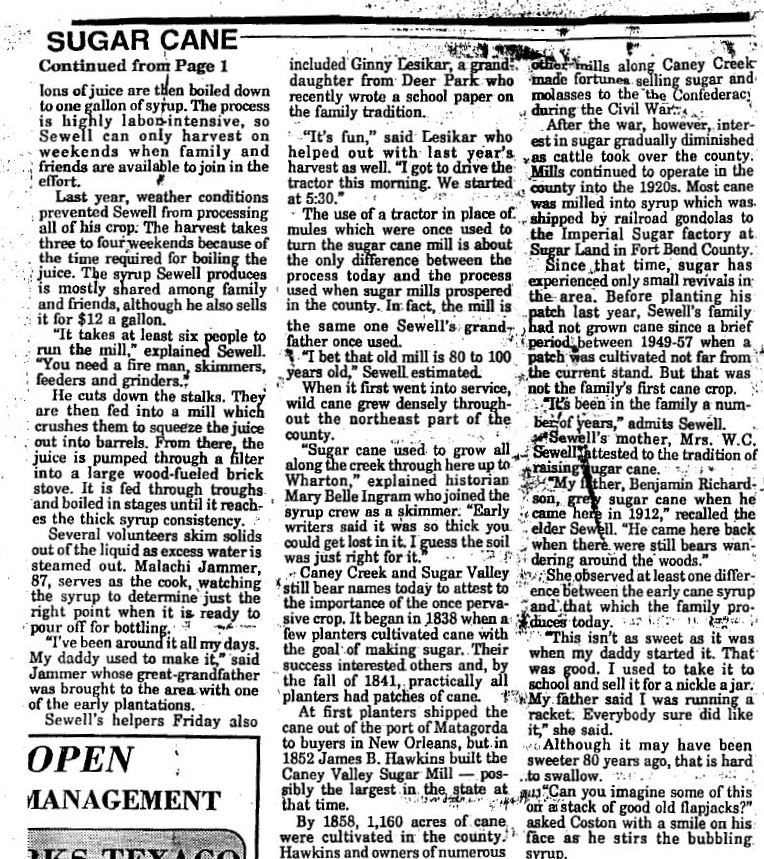
THE LATER YEARS
In time the dirt roads gave way to oyster shell and then blacktop. The little township just never happened but the rural community flourished along Hasima (Hasema) Road and continues today. The following map attempts to highlight where things were about 1952.
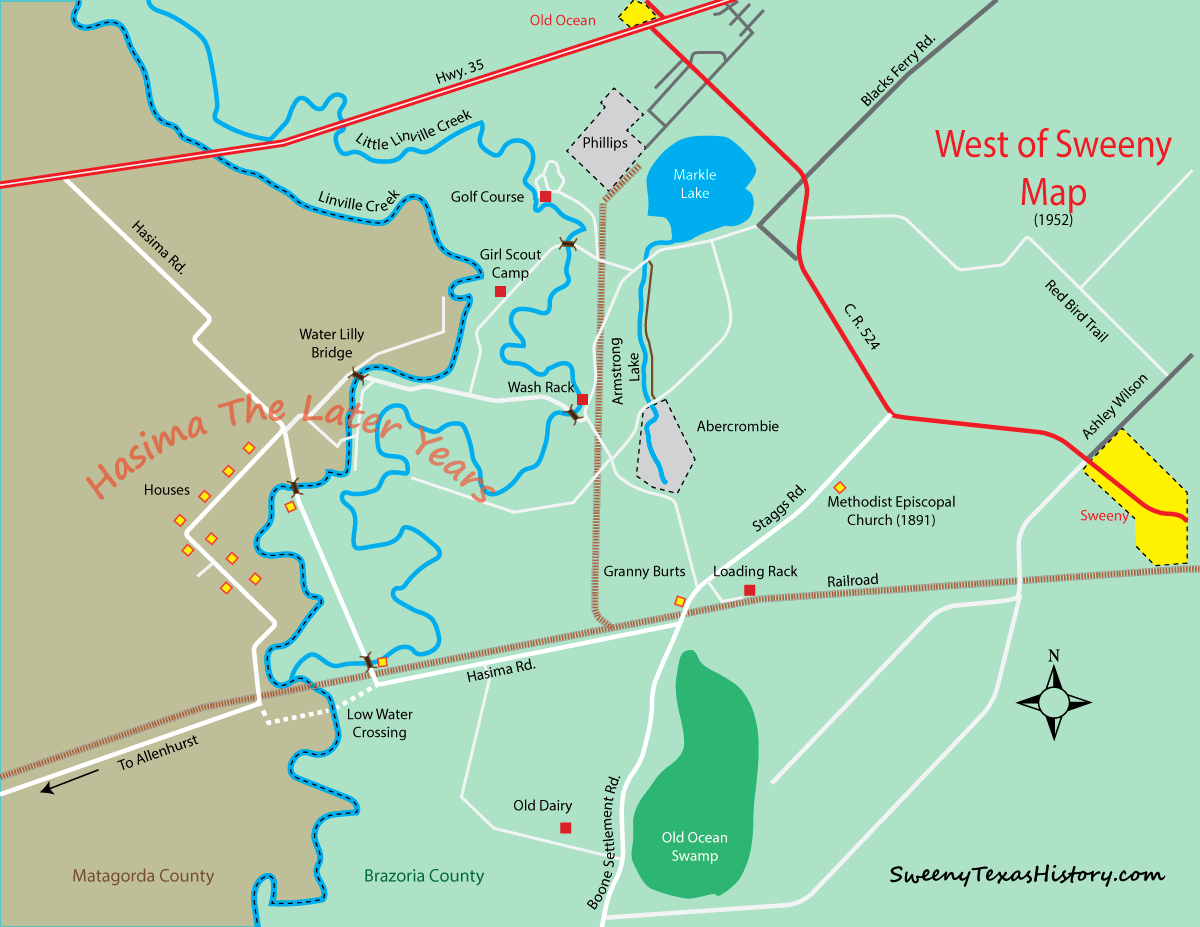
By 2015 there is little or no evidence that the township of Hasima ever existed. The dirt streets and the road thru "town" were abandoned and plowed under as Hasima faded into history.
LINKS
TxGenWeb site for Matagorda County
BRAZORIA COUNTY HISTORICAL MUSEUM
APPENDIX A……Bridge over Linville Creek 1914 historical documents
-
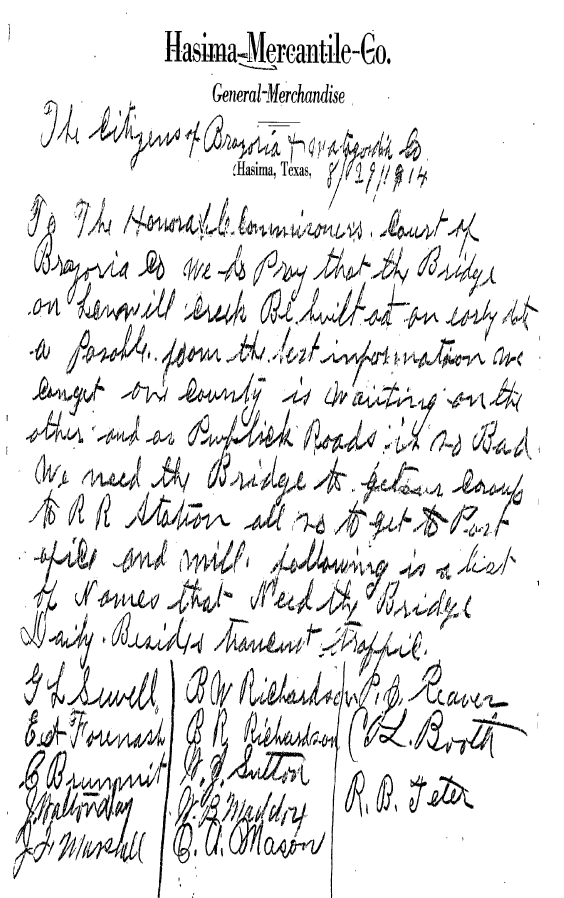
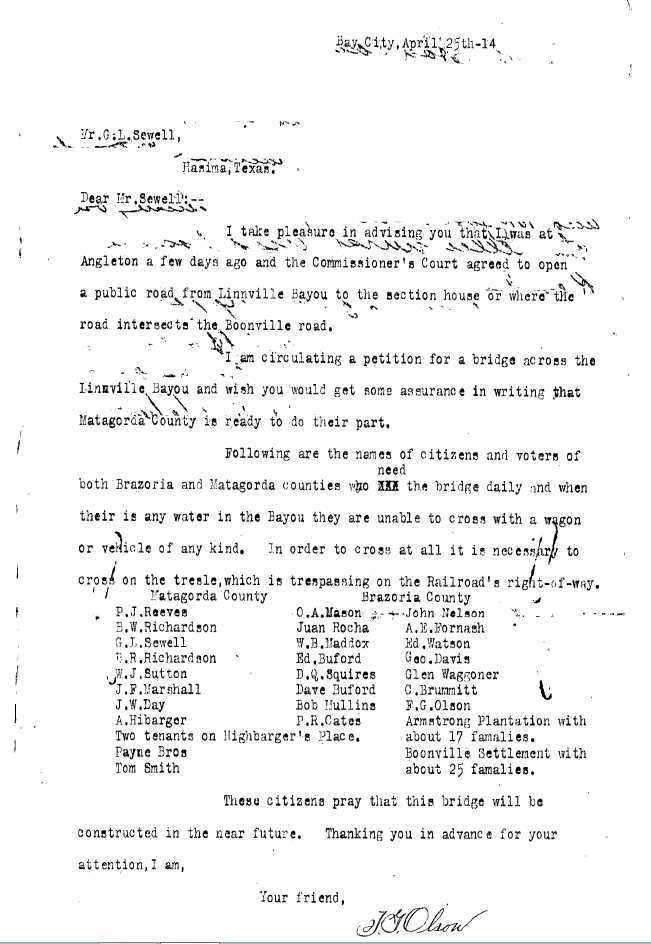
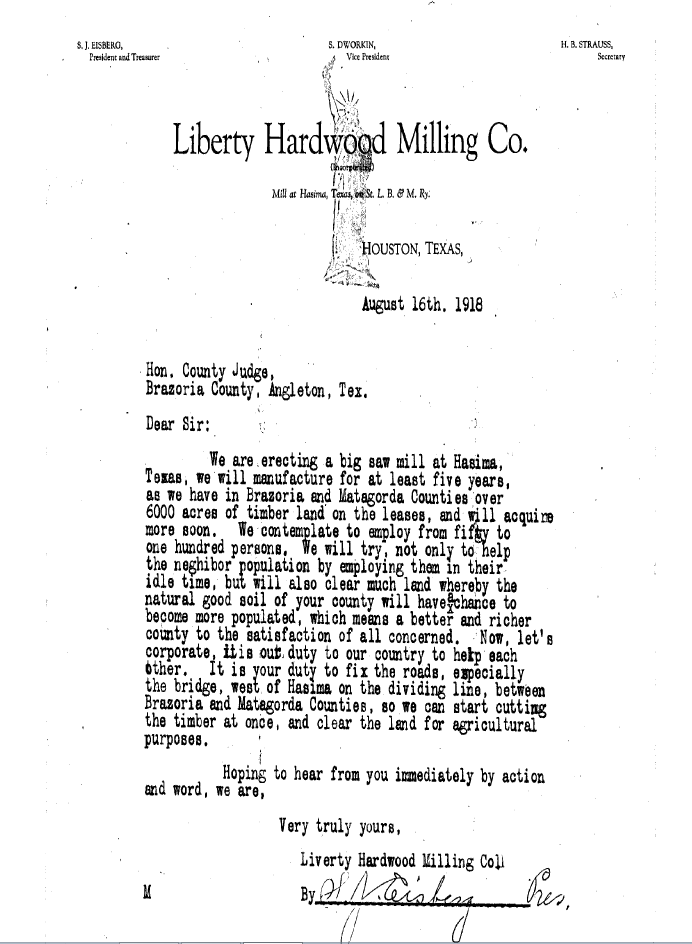
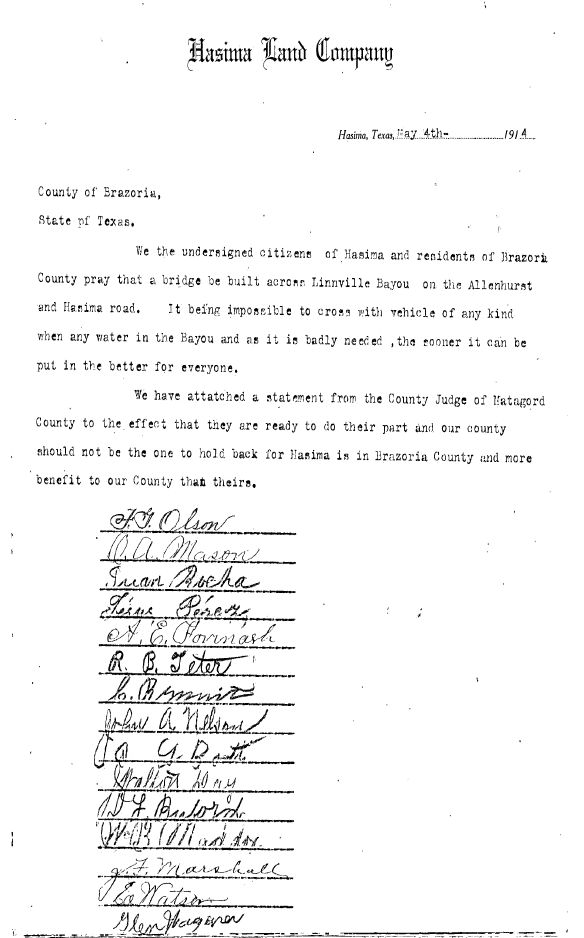
APPENDIX B LAND HISTORY
-
1906 W B Renn acquired the lower 1/3 of the Battle M Berry League from Branch Masterson and others. Masterson had already sold right of way to railroad. (No mention of Hasima)
Jan. 1909 Renn sells the lower 1/3 to McMaster, Morse, Needham and Hearne.
July 1913 McMaster, Morse, Needham and Hearne sell to R D MacDonald the lower 1/3 less lots 1, 2 and 3 block 2 Hasima. They also stipulate (since they held a 5 year lien) the amount MacDonald must have paid them before they release land to him. Within this stipulation lot 20 block 5 is set at $1500 and Farm lot 1 for $2500. Found no reason to explain high value. Still cannot explain the high value lots since a typical lot was $25.00. My guess is a water well was on one of them.
July 1913 McMaster, Morse, Needham and Hearne sell lots 1, 2 and 3 block 2 Hasima to A L Jackson.
Jan. 1914 Jackson sells lots 1, 2 and 3 block 2 Hasima to H F Meyers with note plat is on file at Angleton.
March 1915 MacDonald sells to A J Forinash lots 9 and 10 Block one. Lots were described as metes and bounds (No mention of Hasima). Deed also states Forinash was occupying the lots? Forinash also signed road/bridge petitions in 1914.
Dec. 1916 Meyers sell lots 1, 2 and 3 block 2 Hasima to P J and Maggie Reeves. With improvements indicating something was built on the lots.
Oct. 1924 Forinash sells lots 9 and 10 Block one to J S Richardson with Hasima Plat attached. (See document I emailed earlier). Richardson own lots until 1965. 46
1935 Reeves sell lots 1, 2 and 3 block 2 Hasima to MacDonald.
1941 MacDonald ask for and is granted cancellation of Hasima townsite.
whl

